Abstract
The incorporation of phase change materials (PCM) in buildings has the potential to enhance the thermal efficiency of buildings, reduce energy cost, shift peak load, and eventually reduce air pollution and mitigate global warming. However, the initial capital cost of PCM is still high, and thus the establishment of a control strategy has become essential to optimize its use in buildings in an effort to lower investment costs. In this paper, an extensive review has been made with regard to various control strategies applied to PCM-enhanced buildings, such as ON/OFF control, conventional control methods (classical control, optimal, adaptive, and predictive control) and intelligent controls. The advantages and disadvantages of each control strategy are evaluated. The paper further discusses the opportunities and challenges associated with the design of PCM-enhanced buildings in combination with control strategies.
1. Introduction
In recent years, population growth and industrial developments have resulted in a dramatic increase in energy consumption and greenhouse gas emissions. Figure 1 and Figure 2 show the rising trend of total energy consumption [1,2] and CO2 emissions [3], over the period between 1990 and 2019, respectively. According to the statistics of the U.S. Energy Information Administration, today’s rate of energy consumption is higher than its production, which is a cause of significant concern about the future availability of energy [4]. Studies confirm that the building sector is one of the most prominent energy consumers, worldwide. Almost 50% of energy is consumed in buildings in the USA [5], 40% in Europe, and 36% worldwide, of which space heating and cooling account for approximately 50% [6]. Thus, energy demand with an annual rate of increase of 2.3% has created awareness towards the need to use renewable sources of energy to reduce climate change and achieve sustainable development [7].
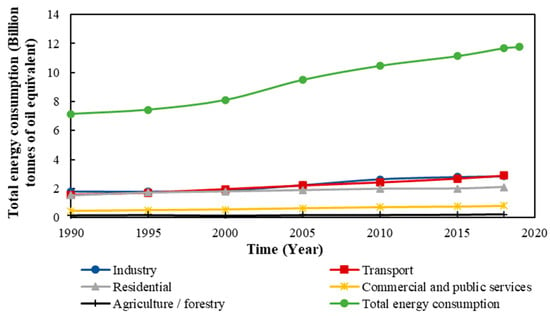
Figure 1.
World’s total energy consumption by sector over the period between 1990 and 2019 [1,2].
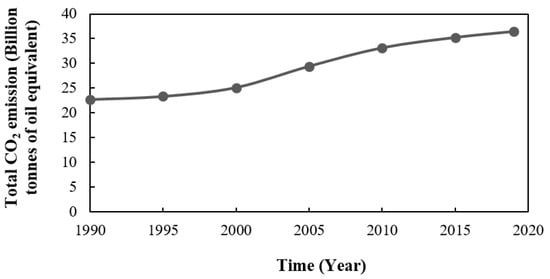
Figure 2.
World’s total CO2 emissions from 1990 to 2019 [3].
Significant attention has been directed to manage the growing energy demand, energy security, and energy consumption pattern, especially by heating, ventilation and air conditioning (HVAC) systems, and their associated grid loads [8]. In many parts of the world, for example, direct solar radiation is a promising source of energy as it is free, renewable, unlimited, and eco-friendly. In solar heating applications, a building can either absorb solar energy passively without requiring any mechanical and electrical devices [9] or use of auxiliary equipment to efficiently convert solar energy to thermal or electrical energy [10]. Solar energy varies according to the time of the day, season, climatic conditions, and other factors. Generally, solar radiation flux reaches its maximum level at midday, while it diminishing to zero at sunset. To tackle this limitation, thermal energy storage (TES) systems allow excess heat or cooling energy to be stored for later use. TES or enhanced thermal mass is that property of materials that defines their ability to absorb, store and release heat according to the surrounding conditions. TES increases the overall efficiency and reliability of heating and cooling by providing thermal comfort and indoor temperature stabilization. Additionally, it reduces the pollution, and CO2 emission associated with fossil fuel use [11].
Thermal energy is stored in materials through sensible heat by changing the temperature of material [12], latent heat by altering the phase of material within a narrow temperature range [13], and through reversible thermochemical reactions [14]. Among different TES systems, latent heat thermal energy storage has attracted wide attention due to its ability to store a large amount of energy per unit volume, isothermally, by using phase change materials (PCMs). Studies show that PCMs can store heat per unit volume 5–14 times more than sensible heat storage materials [15]. Figure 3 compares the thickness of building construction materials required to store the same amount of energy (the energy required to increase the temperature of 240 mm concrete from 20 °C to 30 °C). Thermochemical energy storage materials are also technically complex and challenging to apply, and hence require higher capital expenditure [16].
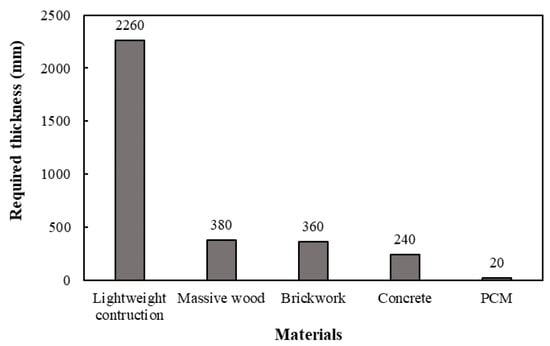
Figure 3.
The thickness of building materials required to store the same amount of energy [17].
PCMs are divided into organic materials, such as paraffin and non-paraffin-based compounds, inorganic materials, such as hydrated salts and metallics, and eutectics [18], which are a mixture of components with a freezing point less than the individual components. Figure 4 illustrates the classification of the PCMs [19]. All PCM types have some advantages and disadvantages [20] which are summarized in Table 1.

Figure 4.
Classification of phase change materials (PCMs) [19].

Table 1.
Advantages and disadvantages of different type of PCM [20].
An ideal phase change heat storage material should exhibit some desirable thermodynamic, chemical, kinetic, and economic properties. Following are some of the criteria used to select the proper PCM [13,18,21].
Thermodynamic properties:
- -
- A melting point within the temperature range of application;
- -
- High latent heat of fusion per unit mass and volume, so that a smaller amount of material is required to achieve a certain energy storage capacity;
- -
- High specific heat capacity to take advantage of significant sensible heat storage effect;
- -
- High thermal conductivity, so that heat could be absorbed or released faster;
- -
- Small volume changes during the phase transition;
- -
- Congruent melting;
- -
- Small vapor pressure.
Chemical properties:
- -
- Experiencing reversible freezing/melting cycle;
- -
- Chemical stability which means being non-corrosive and not being decomposed during the freezing/melting cycle;
- -
- Non-toxic and non-flammable.
Kinetic properties:
- -
- High nucleation rate to avoid supercooling;
- -
- High rate of crystal growth to meet demands of heat recovery from the storage system.
Economic properties:
- -
- Cost-effective;
- -
- Available in large quantities.
1.1. Incorporation of Phase Change Materials (PCMs) into Buildings
Old buildings were designed based on heavy-weight construction to provide high thermal mass, and hence could moderate indoor temperature during all seasons. The thermal property of such construction significantly enhanced indoor comfort without the need for mechanical air conditioning systems [22]. Breaking with this tradition, the tendency to implement light-weight construction elements has increased. Light-weight materials enable the use of prefabrication and on-site assembly, which is cost-effective and less time-consuming [23]. They also consume less raw materials and reduce the mass of buildings which in turn decreases the damage-related issues associated with earthquakes [24]. However, the low thermal mass of light-weight materials subjects the building to indoor thermal fluctuations, which raises the need for heating and cooling systems. The emergence of PCMs, on the other hand, could counteract the limitations of light-weight buildings [25]. Studies show that PCMs have a great potential for providing dynamic thermal capacity in light-weight constructions [26].
In general, the energy analysis of PCM-integrated buildings strongly depends on the PCM melting point, latent heat, location, and the amount of the PCM incorporated into the building, as well as the climatic conditions and the design of the building [27]. In particular, thermal comfort can be determined based on the type of building, as well as the season of the year. Usually, thermal comfort should be within the range of 22 °C to 27 °C in summer, and 18 °C to 25 °C in winter [28]. Therefore, for building applications, the melting temperature of PCM should lie between 18 °C and 27 °C [29].
On the other hand, PCM cannot provide significant benefit in severe weather conditions or in climates having minimum daily temperature variation. Likewise, PCM application is useful only if upper limit of comfort level in summer and lower limit in winter are maintained. In fact, in summer, PCM application is useful only if the upper limit of comfort standard set by the World Health Organization is maintained, while it cannot provide the lower limit of comfort level at 18 °C.
PCMs are incorporated into buildings through both passive and active applications. In the passive application, PCM is embedded into building construction materials without using any auxiliary equipment [30], which increases the thermal storage capacity of the building materials. In the passive technology, PCM is incorporated into the building envelope through different approaches such as PCM-enhanced covering materials like drywall (also known as plasterboards, wallboards or gypsum boards) [31,32,33], concrete [34,35] and ceramic [36,37], macro-encapsulated PCM panels [38,39,40], multi PCM (honeycomb) structure [41,42,43,44], and PCM-impregnated insulations [45,46,47]. Typical applications of passive PCM technologies include the integration of PCM into the building fabrics of walls, floors, and roofs. In addition, they can be incorporated into the fenestration, insulation, façade, shutter, and shading systems of the building [48]. For example, Saxena et al. [49] evaluated the effect of PCM-embedded bricks for passive conditioning of a building. A heat transfer reduction between 40% and 60% was achieved, during a summer day.
Active PCM system requires some mechanical or electrical energy for its operation [30]. In the active system, PCM is contained in a heat storage unit, which may be placed inside or outside the buildings. Active systems are preferred where more precise control of the system or greater heat transfer performance is needed [50]. It can integrate the PCM into HVAC systems (such as air conditioning units, floor heating and ground heat pumps) [51,52,53,54] or in storage containers [55,56,57] in the vicinity of the building (such as an aquifer [58], borehole [59], pits, or tanks [60]) [61]. The active PCM application allows the system to absorb, store and release heat on demand, which results in a more efficient heat transfer and less energy consumption in a building, but with the penalty of high cost. Jeon et al. [62] showed that the application of a radiant floor in combination with PCM, as an active system, can reduce the heating demand of residential buildings, in Korea, by 45%.
1.2. The Application of Control Strategies in PCM-Enhanced Buildings
Energy saving in buildings can be achieved through the use of novel HVAC devices, innovative system design and integration, and operational management and control [63]. Incorporation of phase change materials into buildings has already been introduced as an effective approach, as these can bridge the mismatch between energy supply and demand through their large energy storage capacity [64]. However, the application of control strategies and investigating the energy performances of such systems remain a challenge [65]. Active thermal energy storage systems, on the other hand, require high investment costs. Thus, the application of an appropriate control strategy is necessary to maximize the energy benefits during its operation. Applying such automation can effectively reduce operating costs and energy consumption, which contributes to climate and environmental protection without sacrificing comfort [66].
Over the last decade, there have been numerous review papers on energy management techniques [67], control strategies applied to buildings to ensure indoor thermal comfort [68], and peak load shifting [69]. However, to the authors’ knowledge, there is no literature review on the application of different control strategies to PCM-enhanced buildings. Moreover, researchers have applied some controllers in PCM-enhanced buildings without explaining the reasons for selecting them over others. This paper comments on the advantages and disadvantages of different control strategies in order to increase the potential benefits of using PCM in buildings.
In this review paper, literature search was done first for different control strategies that were applied to buildings. Then, the applications of selected control strategies into PCM-enhanced buildings were covered. Finally, the advantages and disadvantages of these control strategies as well as future opportunities and challenges were sought.
2. Different Control Strategies Applied to PCM-Enhanced Buildings
Different control strategies have been applied to PCM-enhanced buildings to control the operation of the mechanical and electrical devices and hence ensure indoor comfort and minimize electricity consumption, cost associated with energy consumption, and CO2 emissions. Control strategies can be divided into different categories such as ON/OFF control, classical control (P, I, PI, PID, etc.), adaptive, optimal and predictive control, and intelligent controls [68], which are discussed thoroughly in the following subsections.
2.1. ON/OFF Control
ON/OFF control, also known as hysteresis control, is the simplest feedback control method that switches the manipulated variable between two states of ON or OFF, abruptly. ON/OFF controller uses the upper and lower bound of the objective variable to regulate the process within the given thresholds [70]. As an example, Gholamibozanjani and Farid [71] implemented an ON/OFF control strategy in an experimental hut equipped with PCM storage to ensure its thermal comfort in different seasons of the year. In winter, for instance, the PCM storage system was ON if the PCM temperature was higher than the indoor room temperature; otherwise, an electric heater was automatically started to maintain the comfort condition. Such controllers can drive the manipulated variables from a fully open to a fully closed state and vice versa over a specified period. Solgi et al. [72] implemented a night ventilation technique to lower the summer cooling demand of an office building in hot-arid areas. The night ventilation was scheduled to automatically start once the outdoor temperature dropped below 30 °C and to stop at 7 a.m., thus solidifying the PCM using the coolness available at night and then melting it to absorb heat during the day.
Although the ON/OFF control method is inexpensive, simple and easy to implement, it is not able to control dynamic processes with time delays [73] as it is either fully ON or fully OFF, and hence causes chattering in the control output. In fact, a proper hysteresis is required, which otherwise would make output deviate from the temperature set-point. Moreover, considerable signal noise is introduced to the measuring process, which results in inaccurate output measurements [74].
Kenisarin and Mahkamov [75] performed a review on controlling thermal comfort in small laboratory models and real-size test rooms enhanced with a PCM applied passively. Implementation of such control strategies aims to meet different primary objectives such as energy-saving, electricity cost-saving and peak load shifting while maintaining indoor thermal comfort; these are discussed in depth in the following subsections.
2.1.1. Overall Energy Consumption Reduction
Application of control strategies to a building can enhance its energy efficiencies and hence reduce the pollution associated with fossil fuel consumption used for power generation [76]. Chen et al. [77] examined the effect of combined night ventilation and thermal energy storage using PCM to reduce the energy consumed for space cooling in an office building. In their simulation-based study, a typical south-facing office room located in Beijing, China, was considered as a base case for their study; also, a control algorithm was implemented to regulate the indoor temperature. Based on the control algorithm, during the period from 8 a.m. to 6 p.m. (office hours), fresh air was always provided for the occupants. However, if room temperature exceeded the higher bound of comfort level by 1 °C, the PCM started cooling down the room. If room temperature exceeded the comfort level by 2 °C, and the 3-min shut-off period of the air conditioner was met, the air conditioner would hence start. During the night (from 6 p.m. to 8 a.m.), outdoor air was introduced to the storage unit to solidify the PCM to be used during the following day. The results showed that it was possible to achieve energy saving between 16.9% and 50.8%. Another example of night ventilation, based on the ON/OFF control algorithm showed reduced electrical energy consumption and as a consequence reduced CO2 emission [78].
In addition, by using a simulation tool, Transient Systems (TRNSYS), Wang et al. [79] proved that the implementation of a control strategy into a ground heat pump system in conjunction with PCM reduced electrical energy consumption in Xi’an (Humid Subtropical Climate in China). They showed 7.9 °C improvements in the average temperature of the heat pump with an increase in its average coefficient of performance (COP) from 3.4 to 3.8.
Table 2 summarizes the studies carried out on the application of ON/OFF controller in combination with PCM for the sake of reducing energy consumption and indoor temperature fluctuation. In this table, type of PCM used and its integration place, the reason for using a controller, scale of the study, type of study (experimental/numerical) and energy benefits were reported.

Table 2.
Application of ON/OFF controller in PCM-enhanced buildings for energy consumption reduction.
2.1.2. Cost Saving
Integration of PCMs into buildings can serve to make energy-savings by storing solar energy for later use (heating) or by storing free cooling available at night in summer (cooling). Changing the electricity consumption pattern by end-use customers, on the other hand, plays a significant role in managing demand resources and cost-saving. In this regard, postponing the use of electricity during high wholesale market price periods and using it during cheaper hours is an effective approach to demand responses [69]. For example, in 2015, Barzin et al. [93] initiated a “price-based” control strategy in a PCM-enhanced building for space heating. They examined the potential of PCM technology in conjunction with underfloor heating in an office-size building at the “University of Auckland,” New Zealand. Figure 5 shows a general view of the data acquisition and control system applied to their experimental building. According to their control system, the underfloor heater was switched ON or OFF based on the online dynamic electricity price, price constraint, and desired room temperature, which algorithm is shown in Figure 6. The experimental measurements over five days in winter confirmed a total energy-saving of about 18.8% with a corresponding 28.7% of cost-saving, while the highest energy and cost-saving were equal to 35% and 44.4%, respectively.
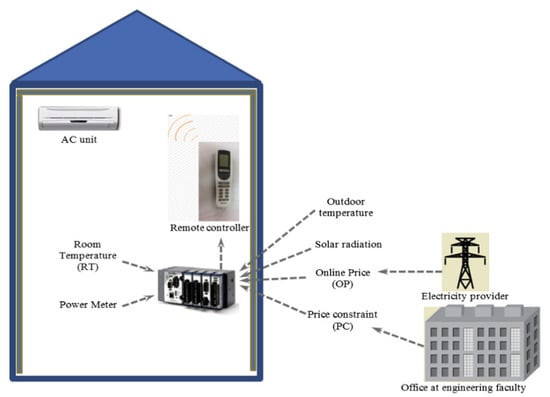
Figure 5.
Control system used in Barzin et al. study [93].
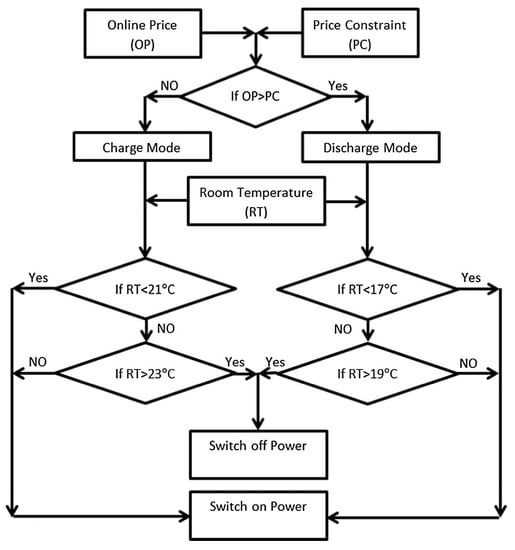
Figure 6.
The control strategy applied to the huts of the University of Auckland for passive space heating [93].
Barzin et al. [6] also implemented a price-based control strategy for space cooling in summer, based on the weather conditions in Auckland which has a “Marine West Coast Climate”. Two similar experimental huts (interior dimensions 2.4 m × 2.4 m × 2.4 m), each constructed with light-weight materials and provided with 1 m × 1 m north-facing windows, were used to perform some experiments. One of the huts, referred to as “hut 1”, was considered a reference for experiments, and its walls and ceilings were finished with 13 mm gypsum boards. While the other hut, referred to as “hut 2” was finished with PCM-enhanced gypsum boards. The PCM used was PT20 with a narrow melting temperature of about 20 °C. Both huts were also equipped with air conditioning units. The aim of the “price-based” control strategy was to keep the indoor room temperature in summer between 17 °C and 19 °C during off-peak periods (when the online price was lower than price constraint), and between 24 °C and 26 °C, during on-peak hours (when the online price was higher than the price constraint). An air conditioner was used to provide the comfort condition, but 100% more energy was consumed in hut 2 compared to hut 1, over 6 days. Therefore, they tried applying night ventilation in combination with air conditioning during the daytime, showing an energy-saving of about 73% over one week.
2.1.3. Peak Load Shifting
Peak demand or peak load is referred to as the maximum demand over a specific billing period. Peak demand usually varies for different types of buildings. Usually, residential users are charged based on a single tariff rate and only recently some electricity suppliers provided a variable electricity rate for the sake of peak load shifting. The incentive of peak load shifting for residential users would be electricity cost saving as well as improved quality and reliability of power. Peak demand for a commercial building lasts for a short period; however, it counts for half of the overall electricity bill. Hence, peak load shifting can not only reduce the peak demand, but it also saves substantially on energy costs [94]. Studies show that peak load management can lead to $10–$15 billion cost-saving in the US market annually [95]. Figure 7 illustrates the schematic view of a typical peak load shifting in summer.
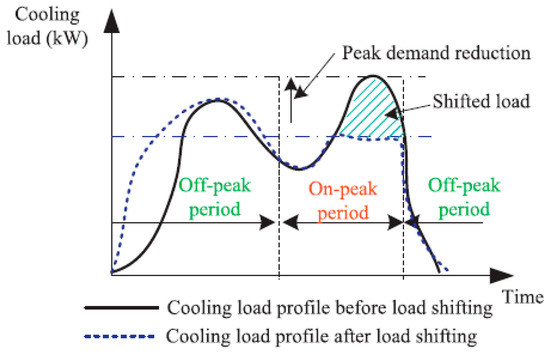
Figure 7.
Overall view of a typical peak load shifting [94].
There are other benefits from offsetting the peak load including the reduction of generation of electricity from non-renewable energy sources during periods of peak demand and resilience during times of power outages. Even if a renewable source of energy is used, its generation during peak demand is not guaranteed as it may be cloudy, for instance, when solar energy is used. Power generation companies usually design their systems based on average load. Thus, any peak demand requires auxiliary equipment which causes extra cost, maintenance, and pollution that can be prevented by peak load shifting. On the other hand, as power generation facilities age, equipment failures accelerate, and as the demand for power increases over the years, existing plants have trouble meeting load requirements. To compensate for this, a plant may elect to install an energy storage system that can be charged when demand is low and discharged when demands cannot be met by the primary generation source.
Shifting of peak load also reduces losses in the transmission and distribution systems and hence carbon emission will be reduced as a result of more efficient operation of power plants and less load variability.
Studies show a significant potential of PCMs in peak load shifting [96]. In most cases, there is either no control strategy or only an ON/OFF control strategy. However, the best results have been achieved with control strategies. Peak load shifting control applied to PCM-enhanced buildings can be divided into two groups based on PCM integration into either the building envelope or into HVAC systems.
In terms of PCM incorporation into the building envelope, Khudhair and Farid [97], proved the concept of peak load shifting by charging the PCM-enhanced gypsum boards using electrical energy during low-demand hours to be used during high-demand hours. In Canada, Bastani et al. [98] also evaluated the effect of an ON/OFF control on shifting heating peak demand of a real bungalow building integrated with PCM wallboards. Through a numerical study via TRANSYS, they considered five different room set-point temperature ranges such as 20 °C–25 °C, 19 °C–24 °C, 18 °C–23 °C, 20 °C–24 °C, and 20 °C–23 °C. The PCM melting and solidification temperatures were 23 °C and 17 °C, respectively. Based on their control strategy, during the off-peak hours from midnight until 5:30 a.m., a heater was set in operation to charge the PCM and hence maintained the room temperature at the upper bound of comfort level. Then, during peak hours from 5:30 a.m. to 9:30 a.m. the heater was OFF, but PCM kept the room temperature at the lower bound of comfort level. Results showed that larger indoor temperature swings resulted in a higher total daily energy consumption and a lower peak load shifting. Moreover, setting the operational temperature range closer to the melting and solidification temperatures of PCM, 18 °C–23 °C, for instance, resulted in better utilization of the PCM and a longer period of peak load shifting. Barzin et al. [99] conducted another price-based control strategy for peak load shifting in winter. In their study, two experimental huts were finished with 13 mm gypsum boards and equipped with identical electric heaters. However, one of the huts was internally lined with DuPont PCM wallboards having a melting temperature of 21.7 °C. The indoor air temperatures were planned to be kept between 21 °C and 23 °C during off-peak hours, and between 17 °C and 19 °C, during peak hours. The thermal performance of the hut was then compared. Table 3 summarizes the energy and cost-savings of the PCM-enhanced hut over six days, based on the weather conditions in Auckland.

Table 3.
Power and cost-savings for six days of winter [99].
Peak load shifting can also be achieved through the integration of PCMs into heat exchangers [100]. For instance, the potential of an air-PCM heat exchanger unit for peak load shifting was investigated by Stathopoulos et al. [101] in France. In their experimental work, a heat exchanger unit composed of a set of plates containing paraffin having a melting point of 37 °C (Figure 8) was integrated into a ventilation system in a test cell, known as “Hybcell”. Considering thermal comfort and indoor air quality of Hybcell, the aim was to reduce peak demand, particularly during late afternoon periods in winter. To this end, a preliminary control strategy was introduced to evaluate the capability of the system for peak load shifting. An electrical resistance heater was also provided to charge PCM and warm up the test cell during off-peak hours, then the PCM was discharged during peak hours. The experimental measurements showed that the proposed design allowed peak load reduction while the Hybcell met the thermal comfort requirement of 21 °C. On the other hand, a numerical model was developed using the specific heat capacity method, developed by Farid [102], and coupled to a building simulation program. The model could accurately predict the experimental measurements. Figure 9 compares the calculated and experimental results of the heat exchanger unit and the test cell performance during a four-day test, where the grey highlighted parts correspond to the peak demand period (6 p.m. to 8 p.m.).
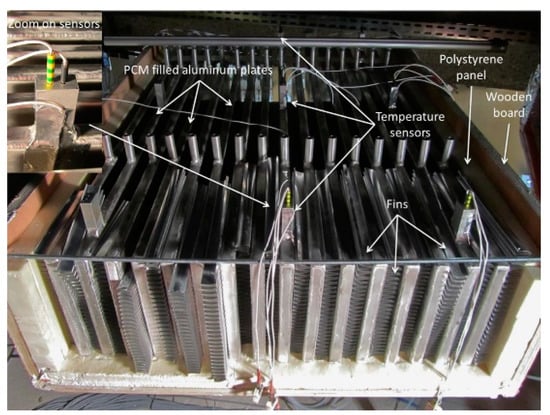
Figure 8.
PCM storage unit used for peak load shifting in Stathopoulos et al. study [101].
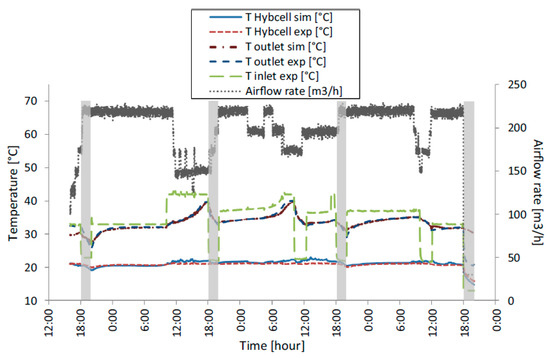
Figure 9.
Numerical and experimental results for the PCM storage unit for peak load shifting over four days [101].
Using PCMs in underfloor heating is another method that can not only reduce electricity costs but also shift the heating load to off-peak hours. Devaux and Farid incorporated a PCM (melting range 27–29 °C) in an underfloor heating system in combination with another lower melting point PCM (21.7 °C) in the walls and ceiling of a 2.63 m × 2.64 m × 2.64 m hut. The results showed that the lower melting point PCM helped to maintain comfort condition, while the higher melting point PCM, in the underfloor heating system, created peak load shifting with energy and cost saving of 32% and 42%, respectively [103].
Table 4 shows the application of ON/OFF controller for peak load shifting in some other studies.

Table 4.
Application of ON/OFF controller in PCM-enhanced buildings used for peak load shifting.
2.2. Classical Control
P (Proportional), I (Integral), D (Derivative), PI (Proportional-Integral), PD(Proportional-Derivative), and PID (Proportional-Integral-Derivative) are the most commonly used classical controllers [70]. In process control, a correction is applied to a system based on the feedback received from the system. The action of the P controller is proportional to the difference between the set-point and the measured value [70]. The output of the I controller is proportional to the integral of the error with respect to time [117]. Finally, derivative control is the mode of control where the response is based on the derivative of the error with respect to time [118]. A PID controller, however, considers the features of all P, I, and D controllers, as shown in Figure 10. The advantage of classical controllers over ON/OFF controllers is their ability to adjust outputs to any values between 0% and 100%. Therefore, classical controllers are used when a stable and more precise control is required.
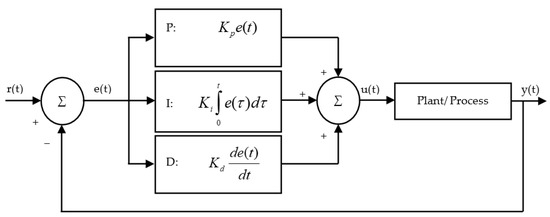
Figure 10.
The diagram of a Proportional-Integral-Derivative (PID) controller.
In terms of PCM-enhanced buildings, only three types of controllers were studied. Dehghan and Pfeiffer [119] carried out a numerical study to reduce the energy consumption of a building (retrofitted with PCM on its floor), while sustaining comfort. The building incorporated PCM in the underfloor heating system. A water tank charged by either solar energy during the daytime or an electric boiler during the night was used to pump the water into underfloor tubes. The surplus of solar energy was stored in the PCM for later use. In this regard, a thermostat having a built-in P controller was implemented to switch ON the electric boiler when solar energy was not enough to maintain the comfort condition. The results showed that the application of a control strategy enhanced the performance of the proposed system for space heating.
Wu et al. [120] coupled PCM storage with a heat pump to reduce the operating cost and energy consumption of a refrigeration system used to cool a building. A PI controller was used to control the expansion valve opening and hence maintain the superheat at the evaporator exit. A dynamic model was then constructed to consider the phase transitions within the heat pump’s heat exchangers and PCM storage tank. This mathematical model could successfully predict the experimental measurements. Buonomano et al. [121] developed a model in MATLAB to predict the energy demand of buildings equipped with PCM energy storage, PV/T collector, sunspace and smart daylighting systems. The model was developed based on the energy design of non-residential Nearly Zero Energy Buildings (NZEB) under Mediterranean weather conditions. A PI control scheme was used to find the optimal design for the location of PCM in building envelop, PV/T configuration and windows topology and hence minimize the heating and cooling demand of the building. The optimum design resulted in 17% energy saving.
In addition, through Transient systems- Computational fluid dynamics (TRNSYS-CFD), a simulation-based study (Figure 11), Gowreesunker et al. [122] evaluated the energy performance of a displacement ventilation system in the departure hall of an airport. The evaluation was performed by investigating the energy demand of a displacement ventilation diffuser retrofitted with a PCM heat exchanger and comparing it with that of the diffuser-only. A PID controller was also used to control the operation of HVAC system and hence maintain the comfort temperature of the hall between 18 °C and 23 °C. The results showed that the PCM storage improved the energy efficiency of the HVAC system for cooling more than heating (34% for cooling versus 22% for heating), and a maximum energy-saving of about 34% was achieved. Cabrol and Rowley [123] used the TRNSYS simulation tool for a domestic building to analyze the thermal benefits of a concrete floor embedded PCM, in combination with an air-source heat pump for creating peak load shifting. To this end, a building with the dimensions of 12 m × 10 m × 2.4 m was provided with underfloor heating controlled by a PID controller to sustain indoor thermal comfort (at 20 °C) over 360 h in different locations of UK. The control system was designed to use off-peak tariff options, and hence minimize the costs associated with the use of the heat pump. They reported that although incorporation of PCM enhances the thermal stability of a building, its selection depends on fabric construction of buildings.
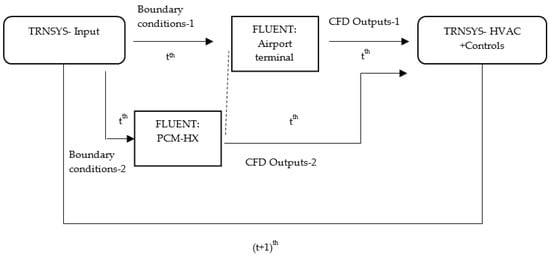
Figure 11.
The diagram of TRNSYS-CFD coupled simulation [122].
2.3. Optimal, Adaptive and Predictive Control
2.3.1. Optimal Control
An optimal control method is a branch of applied mathematics used to minimize/maximize a performance index of a dynamic system, subject to some constraints, over a certain period [124]. Classical controllers are more suitable for linear systems; however, real systems are usually more complex, multivariant and nonlinear, for which optimal control is advantageous. Furthermore, optimal control can handle constraints and time-varying disturbances. The optimal control can be used for scheduling various thermal energy storage systems connected to smart grids [125]. In addition, it can be applied to buildings integrated with PCM passively [126] or actively [127]. Zhu et al. [128] carried out a numerical study to evaluate the impact of optimal control methods applied to commercial buildings, which are equipped with air conditioning units and enhanced with shape stabilized PCM. To this end, a “load shifting” control strategy and “demand limiting” control strategy were implemented to minimize the electricity consumption during peak hours and to minimize electricity used during “demand-limiting” periods, respectively. Based on “load shifting” control strategy, electricity was used to store the lower price cooling energy in PCM during off-peak hours to be used during the on-peak hours. “Demand limiting” control strategy reduced the peak demand by resetting the comfort temperature. The results showed that the use of PCM in the building envelope significantly improved its thermal performance under both control strategies. More than 11% of electricity cost and 20% peak load reductions were achieved. Hajiah and Krarti [129] showed that use of optimal control in TES systems leads to a 28% reduction of total energy cost compared to a conventional control strategy.
Hajiah et al. [130] presented a simulation-based study to investigate the benefit of utilizing a building thermal mass in combination with an ice storage system in the objectives of minimizing the cooling demand and associated costs. An optimal control strategy was implemented to use a chiller to cool down the room and solidify the ice storage tank during off-peak hours, followed by melting the ice during peak hours. In this simulation, building descriptions, utility rates and weather data were fed. Then, considering the building dynamics, thermal loads, available energy sources, and thermal comfort, the optimal control strategy was applied. The simulation results were then validated against controlled laboratory-scale experiments and showed a reasonable agreement. In addition, they conducted some parametric analyses to investigate the parameters that were effective in reducing the total operating costs [131]. The numerical analysis was based on the optimization of the energy cost, size of the cooling system, ice storage tank capacity, and weather data. The results showed that the implementation of optimal control strategy into a building, equipped with a combination of a thermal mass and ice storage tank, could save up to 40% of total energy cost in commercial buildings. Table 5 summarizes some other applications of the optimal control used in a PCM-enhanced building.

Table 5.
Application of ON/OFF controller in PCM-enhanced buildings used for peak load shifting.
2.3.2. Adaptive Control
Adaptive control is a control scheme in which the controller adjusts itself to recognize the parameters that are unknown or time-dependent, without a priori information about the dynamic model of the system [136]. However, actuator nonlinearity is the most obvious limitation of adaptive control method [137]. Thus, only a few researchers have employed adaptive controllers in their systems. Bandarra Filho et al. [138] indicated that adaptive control strategy reduces energy consumption of a refrigeration system by 18%, compared to an ON/OFF control strategy. Buonomano et al. [139] implemented a novel optimal Model Reference Adaptive Control method into a PCM-retrofitted building to control indoor air temperature and humidity. The proposed control method was implemented into MATLAB using a building simulation model, DETECt 2.3, to predict space heating and cooling demands and loads, PCM performance, indoor temperature, and humidity. In principle, the reference model represented the desired dynamic performance of the building, and the control challenge was to determine adaptive mechanisms to provide the indoor room temperature and humidity based on those of the reference thermo-hygrometric profile (Figure 12). The control method was then applied to different case studies with different geometries, construction materials (also enhanced with PCM), and under different conditions to analyze the effectiveness and robustness of the method. The results confirmed that the adaptive control method could successfully guarantee thermal comfort despite uncertain conditions.
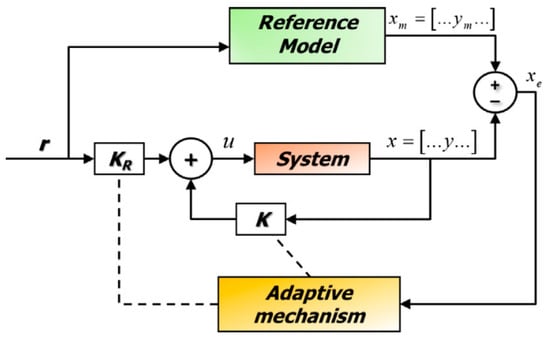
Figure 12.
Landau’s Model Reference Adaptive control scheme [139].
2.3.3. Predictive Control
Model predictive control (MPC) is a powerful optimization-based strategy, in which a plant model is used to predict the future behavior of manipulated variables and the effect of control actions on the evolving state of the plant, over a receding horizon. These predictions are evaluated in an optimization based on an objective function (for example, cost function) and use the current state of the plant as the initial state, subject to some constraints. Then, the sequence control responses are applied to the plant [140]. Figure 13 shows the basic structure of the MPC strategy.
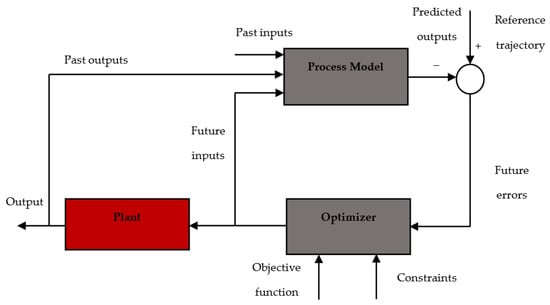
Figure 13.
Basic structure of Model predictive control (MPC) strategy [141].
MPC strategy is a type of optimal control (discussed in Section 2.3.1) that has the ability to predict the future behavior of a system, over a receding horizon. MPC strategy was first applied to PCM-enhanced buildings by Fiorentini et al. [142], in 2015. They investigated the performance of a hybrid MPC strategy to control a solar-assisted HVAC system, used in “Team UOW(University of Wollongong) Solar Decathlon House”, in Australia (Figure 14). The HVAC system consisted of a PV/T collector and PCM, integrated into a heat pump. This system was used for both space heating and cooling, using solar energy and night sky radiative cooling, respectively. High and low-level controllers were implemented to control the system. The high-level mode was based on a 24-h prediction horizon and 1-h control timestep. The low-level controller operated with a 1-h prediction horizon and a 5-min control step. The low-level controller was used to control and optimize the operating mode selected by the high-level controller, such as charging the PCM by solar collector or discharging PCM to heat the building. Results confirmed that the hybrid MPC chose the operation mode appropriately, and indoor thermal comfort was thereby ensured. In addition, the overall energy efficiency of the system was optimized. Later they demonstrated the hybrid MPC operation through a simulation-based study [143]. Figure 15 shows that their simulation could predict the indoor temperature well.
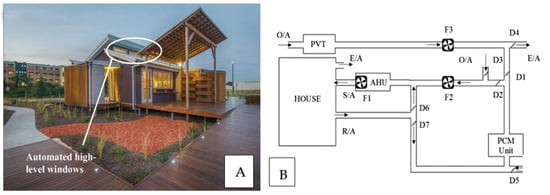
Figure 14.
(A) The “Team UOW Solar Decathlon House”, (B) the overall view of HVAC system [143].
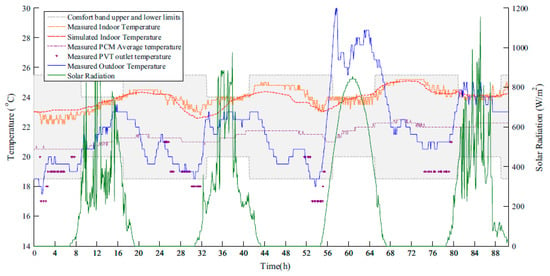
Figure 15.
Temperature profile generated by the application of the hybrid MPC strategy in presence of available solar radiation in March 2015 [143].
There are not many studies on the application of MPC in PCM-enhanced buildings. These studies have considered different objective functions such as energy [144], energy cost [145], and PCM performance [146] in MPC strategies. For example, Touretzky and Baldea [145] performed a numerical study to minimize the electricity cost of a building incorporating passive and active PCM technology, as shown in Figure 16. They proposed a hierarchical, centralized control strategy in which a dynamic schedule was considered for active PCM on a slow time scale, and a control schedule was planned for managing the passive PCM on a fast time scale. The slow and fast time scales were related to a longer time horizon (up to a 24-h period) and a shorter time horizon (a few minutes), respectively. The proposed control strategy led to a great cost-saving (64% to 88%) and showed a better performance compared to the heuristic control even under uncertainties in forecasting building loads.
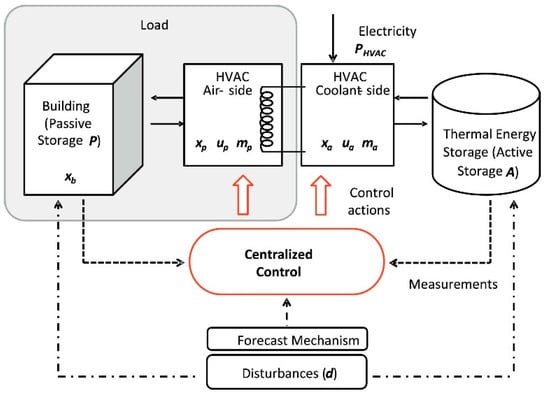
Figure 16.
Centralized MPC strategy applied to PCM-enhanced building [145].
Gholamibozanjani et al. [147] also looked into the importance of economic MPC strategy on the thermal efficiency of domestic, service, and office buildings with different time schedules, based on the weather condition of “Auckland”, during winter. In their study, buildings were equipped with a solar air heater, an air-based PCM storage charged by the solar heater, and an electric heater. The MPC strategy was aiming to utilize the energy captured by the solar heater, followed by the heat stored in PCM and only then the electric heater (Figure 17) in order to minimize the use of electrical heating. To this end, the thermal behavior of the buildings was simulated using EnergyPlus software and saved in an Excel file. The data were then inserted in Python to choose the optimal control. Figure 18 illustrates the profile demand obtained from EnergyPlus together with the sources of energy used to satisfy the heating demand of different buildings while minimizing the cost. The results showed that the domestic building, which was planned to sustain comfort from 6 p.m. until midnight, experienced the highest cost-saving (about 57%) as a result of utilizing the high latent heat of the PCM, which was charged using daytime solar radiation. However, the service building, which had to be kept within the thermal comfort level for 24 h had the lowest cost saving (about 11.46%). In addition, the authors studied the impact of prediction horizon and control step (as MPC parameters), on energy cost-saving. As a result, extending the prediction horizon delivered a higher cost-saving. However, enhancing the control timestep without any limitation provided inaccurate readings of input parameters. This MPC control strategy reduced the cost of energy consumption by about 12% compared to an optimal control scheme. On the other hand, Aswani et al. [148] showed that application of a learning-based MPC strategy into a heat pump reduced energy consumption by 30–70% compared to an ON/OFF controller.

Figure 17.
Schematic view of the automation system applied to different buildings [147].
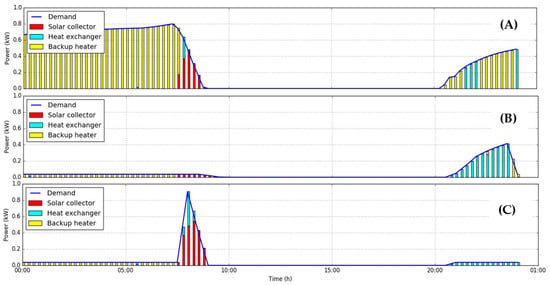
Figure 18.
Demand profiles and sources of energy used to ensure comfort in (A) services, (B) domestic, and (C) office buildings [147].
2.4. Artificial Intelligence (AI)
Nonlinear behavior of the HVAC systems led researchers to implement intelligent control methods to enhance the energy efficiency of such equipment in smart buildings [68]. Unlike classical methods, intelligent control methods do not rely on a mechanistic model but on a learned strategy [149], which may result in a better performance of the system [150]. Artificial intelligence (AI) is an area of computer science in which sets of algorithms, simulation packages, and computational technologies are used to mimic the cognitive functions associated with human minds such as learning, reasoning, social intelligence, problem-solving, and creativity [151]. A variety of AI techniques such as fuzzy logic, genetic algorithm, analytic hierarchy process, simulated annealing, and neural network, as well as AI subsets such as machine learning and deep learning, have been developed and used in energy-efficient buildings [152]. Different AI schemes have been studied to minimize the overall costs, energy consumption, and environmental issues associated with the building sector. Furthermore, a few studies of PCM-enhanced buildings have been carried out using only genetic algorithms, fuzzy logic, and reinforcement learning; these are discussed in the following subsections.
2.4.1. Genetic Algorithm
To solve a problem, machine learning can produce a set of rules which are complete, correct, and concise. However, there are usually trade-offs between the mentioned criteria; such problems are called multi-objective optimization problems, which are difficult or impossible to solve. Hence, genetic algorithms can be used to provide a desirable set of rules by evaluating the strength of the rules based on their responses to the training inputs. The strictest rules are considered as “parents”. New rules are then produced as “off-springs” by genetic operators. In each step, some old and low-quality rules are replaced by new and robust rules, leading to an evolutionary process [153].
There are quite a few studies on the application of genetic algorithms in design-based optimization of PCM storage units [154] and PCM integration into the building envelopes [155]. However, only a few studies have discussed the implementation of a control strategy into a PCM-enhanced building using genetic algorithms. Konstantinidou et al. [156] conducted a simulation-based study using EN adaptive comfort model [157] in combination with multi-objective optimization using a genetic algorithm to minimize the cooling demand and discomfort time of undivided and subdivided office buildings enhanced with PCM. To this end, the application of a control strategy for air conditioning and ventilation patterns was also necessary to fully utilize the PCM and enhance its performance. The effect of some parameters such as materials, thickness, and location of insulation and PCM used was studied. Moreover, some operational conditions such as natural ventilation load, HVAC set-point, and control strategies were applied to investigate the cooling demand and comfort period. The results showed that PCM could reduce the cooling demand and discomfort hours of the undivided office building. However, in the case of subdivided space, a reduction was only observed in the south and east orientations of the buildings, probably due to their exposure to solar radiation. Zhu et al. [158] simulated the thermodynamic behavior of building structures enhanced with shape-stabilized PCM to be able to analyze its thermal performance under different conditions and control strategies. Using genetic algorithm, they predicted the heat transfer between the internal surface and indoor space when indoor comfort level was sustained. Barthwal et al. [159] investigated the economic and environmental aspects of an air conditioning system incorporated cold thermal energy storage system under fully or partially operating modes. The system design was optimized for a commercial building to maximize exergy efficiency and minimize the total investment and operating costs. The optimization was carried out for two different refrigerants, R134a and R717, in the vapor compression refrigeration cycle of the system. The employed thermal energy storage was ice or PCM (salt hydrates). The maximum exergy was achieved when PCM and R717 were used as the TES and refrigerant, respectively, regardless of the operating mode (full/partial).
2.4.2. Fuzzy Logic
Fuzzy logic, which was introduced by Zadeh [160], is a powerful technique to control strongly non-linear and not well-defined systems, to overcome the uncertainties of expert knowledge and experience and to integrate with the conventional control methods [161]. Based on the fuzzy logic the true value of variables may be any real number between 0 and 1, which represents the concept of partial truth, in contrast with the classical set, which are discrete values of either 0 or 1. Indeed, unlike the classical set, fuzzy set allows a smooth membership boundary [162]. For example, there are three ranges for pressure such as low, medium, and high. The classical set considers each temperature as either low, medium, or high; however, this boundary is vague in the fuzzy logic set as shown in Figure 19.
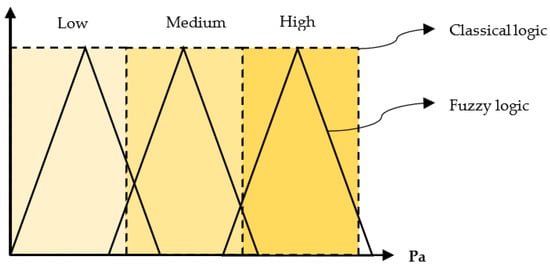
Figure 19.
Representations of classical and fuzzy logic sets [162].
Although fuzzy logic-based controls are flexible, user-friendly, and it is easy to check their consistency, redundancy, and completeness [163], the development of the fuzzy rules, membership functions and fuzzy outputs is tedious and time-consuming. In addition, a lot of data and expertise are required to develop a fuzzy system [164]. Fuzzy logic is sensitive to small changes, so the parameters have to be tuned carefully [165].
Ao et al. [166] used a fuzzy mathematical method to select suitable phase change materials (out of seven chosen PCM) for space heating and cooling of solar buildings in China. Considering the melting temperature, latent heat, thermal conductivity, material cost, and safety, dodecanol was selected due to its highest performance index (0.832 out of 1). Esmaeilzadeh et al. [167] attempted to implement different control systems in a combined solar–gas–electric thermal system, including a PID controller manipulated by fuzzy rule sets, the ON/OFF controller, and fuzzy logic (trial and error) control system. Their objective was to minimize the cost of energy used while ensuring comfortable temperatures in a building in Tehran, Iran. Figure 20 and Figure 21 show a schematic view of the building and the overall controlled strategy applied, respectively. Further, they studied the performance of two energy storage systems, such as hot water and paraffin-based PCM reservoirs, to store the surplus available solar energy. The results showed that fuzzy logic was the most economical method in controlling and optimizing the proposed system (Figure 22). They claimed that in systems with no accurate model, fuzzy trial and errors can result in more efficient control systems. In terms of the energy storage system, both water and PCM were successful in storing the surplus collected solar energy; however, based on the selected PCM and its application, hot water was more economical. The use of control strategy in combination with the energy storage system led to 33% greater energy-saving than ON/OFF and PID controllers.

Figure 20.
The schematic view of the controlled strategy used for energy management in buildings [168].
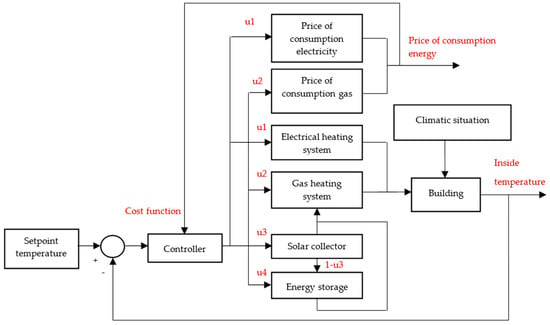
Figure 21.
The overall control strategy applied to the building [167].
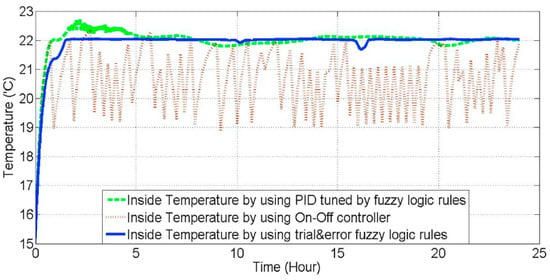
Figure 22.
Effect of different control algorithms on indoor comfort temperature in the house integrating PCM reservoir [167].
2.4.3. Machine Learning
Machine learning is the study of computer algorithms, which builds a pattern and develops a model, based on massive amount of data, known as “training data”. In problems having a large number of variables or for systems that are difficult to model, machine learning is one of the techniques used [169]. With the rapid development of artificial intelligence, machine learning is a promising approach for heating and cooling enhancement of PCM-integrated systems. Machine learning can develop models to be used in model predictive control strategies as well as generation of an optimization function to prioritize time and use of different sources of energy in PCM-integrated buildings. Tang et al. [170] employed a supervised machine learning approach in an exergy-based optimization for a system, and hence improved the system performance by 2.6% from 849.9 to 872.06 kWh. Peng et al. [171] indicated that the application of reinforcement learning reduced energy consumption of an office building between 7% and 52% compared to a conventionally controlled system. Zhou et al. [172,173,174,175] adopted machine learning approach to optimize the geometrical and operating parameters of a hybrid system integrating PCM and perform stochastic uncertainty-based analysis. Later on, Zhou et al. [176,177,178] performed a review study on the application of machine learning in design and smart control of PCM-integrated cooling systems, parametric, and uncertainty analysis and its use in a single/multi-objective optimization for optimal design and robust operation.
Reinforcement learning is a type of machine learning as an application of artificial intelligence [179]. In this technique, a system is trained through the interactions between the learner and environmental evaluative feedbacks to improve its decision-making ability. Reinforcement learning is a system based on a set of states and actions. In each state, an action is taken, and a reward is given. A decision is then taken based on the reward function and discount factor to maximize the cumulative discounted expected reward [180]. However, the need for a large number of experimental measurements [181] or a regression model to generate synthesized data for policy training purposes [182], and large data storage devices are the limitations of the intelligent control systems [183].
Several studies have been carried out using reinforcement learning to ensure the thermal comfort of buildings [184]. Heo et al. [185] reported an energy saving of 14.4% and improved indoor air quality as a result of the implementation of reinforcement learning approach. Reinforcement learning approach has been proved to learn difficult tasks of controlling TES systems and achieve a substantial estimated cost saving [186]. This approach results in more financial benefits over the conventional control methods, but cannot compete with predictive optimal control strategies [186].
In terms of PCM-enhanced building application, de Gracia et al. [187] applied the reinforcement learning technique to control an innovative south-facing ventilated façade with PCM integrated into its air chamber to reduce the cooling energy requirement of an experimental house-like cubicle (internal dimension of 2.4 m × 2.4 m × 5.1 m) built with alveolar brick walls and insulated using 80 mm polystyrene, in summer. To this end, PCM placed in the chamber was solidified using mechanical ventilation (free cooling powered by a fan) at night, and the coolness stored in PCM was released to the room during the peak demand hours, as shown in Figure 23. The schedule of charging and discharging processes of PCM was achieved through optimal control based on the weather forecast and indoor room temperature. This control algorithm was then implemented in cities with different climatic regions (according to Köppen–Geiger climate classification) and thereby improved electrical energy-savings. The comparison of the predicted and real energy-savings in the experimental cubicle in Lleida city, Spain, showed less than 18% variation even though the performance of the system was sensitive to the accurate weather forecast. In another study, de Gracia et al. [188] designed three control strategies with different objective functions such as cost-savings, energy reduction, and CO2 mitigation. They aimed to control the PCM-enhanced ventilated façade using an experimentally validated numerical tool discussed in their paper [187], under different climatic conditions. The PCM system was composed of several flat containers filled with RT21. The control strategies were implemented to optimize the timing and distribution of charging, storing, and discharging processes of PCM and thereby get the maximum benefit. The application of these control strategies resulted in energy-saving in suitable climatic conditions where the nighttime temperature was low enough to solidify the PCM and prevented the possible waste of energy in the case where the PCM was not able to solidify. The averages of energy-saving, cost-saving, and CO2 mitigation were 4.3%, 7.8%, and 16.7%, respectively.

Figure 23.
Operation of ventilated façade in modes of (A) charging process, (B) storage, and (C) discharging processes [188].
Rahimpour et al. [189] applied reinforcement learning technique based on “deep deterministic policy gradient” to a PCM-enhanced building to investigate its thermal performance. This technique eliminated the problems associated with regress model-based methods such as variety in building design and construction types which raises a need for developing and verifying a thermal model for each individual building. This approach can manage the nonlinearity behavior of PCM, as well. The comparison between this approach and other approaches such as “approximate dynamic programming” and “HVAC system with dead-band relay”, over 42 weeks in Sydney, showed a cumulative electricity cost of $696.2, $715.6, and $3256.0, respectively, based on Australian currency.
3. Advantages and Disadvantages of Different Control Strategies
ON/OFF thermostatic controllers are low in cost, simple and easy to apply; however, they are not able to control dynamic processes with time delays, which may cause high energy consumption or large oscillations from the desired temperature set-point. The performance of classical controllers is ensured only if operating conditions remain close to the controller’s tuning conditions, since re-tuning the controller parameters is demanding, laborious and time-consuming [70]. Optimal and robust controllers are promising as they can handle disturbances and time-dependent parameters as well as nonlinear systems [73]. In general, in hard control approaches (classical, optimal, and MPC), it is difficult to guarantee robustness in HVAC systems as they are highly dependent on a lot of time-varying conditions in buildings, and hence each of them requires the specification of additional parameters in which their integration into HVAC system may be difficult and impractical [70]. In addition, these methods usually require a regress mathematical model to predict the performance of the system, properly.
Based on soft control approaches, such as artificial intelligent methods, a system is modelled as a black box, which does not require any understanding of underlying physics of the process. These data-driven models, however, require training data on a wide range of operating conditions, which is not practical for many systems. On the other hand, industries are still not interested to employ a black-box approach in their system [70].
4. Opportunities
The implementation of control strategies is important and better control over the performance of a PCM system provides long-term benefits and compensates for its high cost [190]. Each control strategy has some advantages and disadvantages, and hence the selection should be based on the associated application. HVAC systems, for instance, have a nonlinear behavior and complex dynamic [191]. Therefore, the incorporation of control strategies using artificial intelligence methods, without the need for a physical model of the system, is advantageous. Behrooz et al. [192] claimed that the fuzzy cognitive map method, which is the combination of fuzzy systems and neural network methods, embodies the robust features of both methods and hence is a promising control strategy for reducing the energy consumption of HVAC systems. As discussed in the above sections, there is very little work done on the control strategies using artificial intelligence and its subsections. However, more investigations are required to find a proper, simple, and economic control method.
5. Challenges
PCM technology has the potential to reduce energy consumption under cold, mild, and warm weather conditions [27]. However, in extremely hot and humid climates it may not provide thermal comfort [193] as dehumidification may be required [194]. The cost of PCM is also another crucial factor in designing such systems. Since the early stages of PCM integration into buildings [195] and until recently [196], researchers have been concerned about the high cost of PCM. Under some circumstances, the use of efficient insulation for buildings [155] or an ice storage system [197] is more cost-effective than using PCM, although the latter can save space [197]. Therefore, the wise integration of PCM, in terms of its location, melting temperature, and extent should be considered. In passive applications, as reported by Kissock and Limas [198], the location of PCM depends on the relative convection coefficients of inside and outside surfaces. If convection coefficients for inside and outside are equal, PCM should be placed in the middle of wall to minimize the peak load. However, the convection coefficient of the outside surface is typically larger than that of the inside surface because the former is exposed to wind, higher temperature, and effect of radiation. Hence, the optimal location of the PCM is in the middle toward the inner surface. It is worth noting that the melting temperature of PCM should lie within the comfort zone of the desired building [199]. In addition, to get the maximum benefit of PCM while reducing the capital cost, it should be integrated into the proper orientation of the building’s wall, which is the south and west-oriented walls in the northern hemisphere and north and east-facing walls in the southern hemisphere [200].
The cost of PCM is still high, and hence to get a greater heat transfer performance, active PCM technology is preferred, which enables the system to absorb and release energy on demand and reduce the quantity of PCM needed to create a specific effect. On the other hand, some strategies are required to control such active systems, which may be costly, time-consuming, and require a high level of expertise. Therefore, these control strategies should be designed well and adequately [76]. In addition, problems like sensor faults and control strategy flaws may negatively affect the system performance and efficiency [201].
Model-based control strategies require a regress mathematical model of a process that is difficult to obtain for different types of buildings under different environmental conditions. Data-driven based control methods generate a mathematical relation between input and output data, based on the black-box concept. Thus, the developed correlation works well if the input data is similar to those in the training data set; otherwise, the variability of input data such as different weather conditions, building design, and construction type [189] or different boundary conditions [202] may prevent it from generalization to other systems. Urresti et al. [202] stated that the generalization ability of a system can be improved by using special training algorithms such as “Bayesian Regularization” or training the network by part of the data, and hence testing the system via the remaining data. Hybrid control strategies which involve the combination of hard and soft control schemes inherit the strengths and weaknesses of both control approaches.
6. Conclusions
This review provides an overview of the control strategies applied to PCM-enhanced buildings. In general, there are three main categories of control strategies, namely, ON/ OFF, conventional, and intelligent methods. ON/OFF control strategies rely on a specific schedule such as night/day mode, or an experimental measurement to switch HVAC systems from fully open to fully closed and vice versa. Despite its simplicity, it may create signal noises and hence fail to provide accurate output measurements. In conventional methods, designers should mathematically model the system to be controlled. However, intelligent control methods provide an abstract model of the system based on input and output data. Intelligent controls are the best options when a system is highly nonlinear, challenging, or impossible to be modeled. The intelligent controls, however, require a large number of empirical data or a regression analysis model to generate enough data. Further, appropriate memory and computational saving devices are needed for the data storage to be used for modeling the system behavior.
There are still some challenges with the application of control strategies in combination with PCM-enhanced buildings. The type of PCM, its amount, the location used, and price and climatic weather conditions are some of the essential factors that should be considered. In addition, the implementation of control systems is costly, time-consuming, and requires a high level of expertise.
Author Contributions
Literature research and initial manuscripts writing were done by G.G. Supervision, advice and editing were carried out by M.F. All authors have read and agreed to the published version of the manuscript.
Funding
This research was supported by the International Doctoral Research Scholarship of the University of Auckland.
Institutional Review Board Statement
Not applicable.
Informed Consent Statement
Not applicable.
Data Availability Statement
Data sharing is not applicable.
Acknowledgments
The first author thanks the University of Auckland for providing her with an International Doctoral Research Scholarship.
Conflicts of Interest
The authors declare no conflict of interest.
Nomenclature
| CompactRIO | Compact Reconfigurable Input/Output |
| CFD | Computational fluid dynamics |
| FPGA | Field Programmable Gate Array |
| HVAC | Heating, ventilation and air conditioning |
| I/O | Input/Output |
| LHTES | Latent heat thermal energy storage |
| MPC | Model predictive control |
| NZEB | Nearly zero Energy Buildings |
| P | Proportional |
| PCM | Phase change material |
| PD | Proportional-Derivative |
| PI | Proportional-Integral |
| PID | Proportional-Integral- Derivative |
| PV/T | Photovoltaic thermal |
| TES | Thermal energy storage |
| TRNSYS | Transient systems |
| UOW | University of Wollongong |
| Greek symbols | |
| ΔT | Temperature difference between surface and the environment |
References
- Our World in Data. Global Fossil Fuel Consumption n.d. Available online: https://ourworldindata.org/fossil-fuels (accessed on 25 March 2021).
- International Energy Agency (AIE). Data and Statistics—Energy Consumption n.d. Available online: https://www.iea.org/data-and-statistics?country=WORLD&fuel=Energy%20consumption&indicator=TFCShareBySector (accessed on 21 August 2020).
- Our World in Data. CO2 Emissions n.d. Available online: https://ourworldindata.org/co2-emissions (accessed on 25 March 2021).
- U.S. Energy Information Administration (EIA). Total Energy—Annual Energy Review n.d. Available online: https://www.eia.gov/totalenergy/data/annual/#consumption (accessed on 21 June 2019).
- Pérez-Lombard, L.; Ortiz, J.; Pout, C. A review on buildings energy consumption information. Energy Build. 2008, 40, 394–398. [Google Scholar] [CrossRef]
- Barzin, R.; Chen, J.J.J.; Young, B.R.; Farid, M.M. Application of PCM energy storage in combination with night ventilation for space cooling. Appl. Energy 2015, 158, 412–421. [Google Scholar] [CrossRef]
- U.S. Energy Information Administration (EIA). International Energy Statistics n.d. Available online: https://www.eia.gov/international/data/world (accessed on 14 June 2019).
- Touretzky, C.R.; Salliot, A.A.; Lefevre, L.; Baldea, M. Optimal operation of phase-change thermal energy storage for a commercial building. Proc. Am. Control. Conf. 2015, 980–985. [Google Scholar] [CrossRef]
- Kwok, A.G.; Grondzik, W.T. The green studio handbook: Environmental strategies for schematic design. Enq. A J. Archit. Res. 2007, 4. [Google Scholar] [CrossRef]
- Goswami, D.Y.; Kreith, F. Handbook of Energy Efficiency and Renewable Energy; CRC Press: Boca Raton, FL, USA, 2007. [Google Scholar]
- Dincer, I.; Rosen, M. Thermal Energy Storage: Systems and Applications; John Wiley & Sons: Hoboken, NJ, USA, 2002. [Google Scholar]
- Li, G. Sensible heat thermal storage energy and exergy performance evaluations. Renew. Sustain. Energy Rev. 2016, 53, 897–923. [Google Scholar] [CrossRef]
- Khudhair, A.M.; Farid, M.M. A review on energy conservation in building applications with thermal storage by latent heat using phase change materials. Energy Convers Manag. 2004, 45, 263–275. [Google Scholar] [CrossRef]
- Pardo, P.; Deydier, A.; Anxionnaz-Minvielle, Z.; Rougé, S.; Cabassud, M.; Cognet, P. A review on high temperature thermochemical heat energy storage. Renew. Sustain. Energy Rev. 2014, 32, 591–610. [Google Scholar] [CrossRef]
- Sharma, A.; Tyagi, V.V.; Chen, C.R.; Buddhi, D. Review on thermal energy storage with phase change materials and applications. Renew. Sustain. Energy Rev. 2009, 13, 318–345. [Google Scholar] [CrossRef]
- Abedin, A.H.; Rosen, M.A. A critical review of thermochemical energy storage systems. Open Renew. Energy J. 2011, 4, 42–46. [Google Scholar] [CrossRef]
- Jerz, J.; Simančík, F.; Španielka, J.; Šebek, J.; Kováčik, J.; Tobolka, P.; Dvorák, T.; Orovčík, L. Energy Demand Reduction in Nearly Zero-Energy Buildings by Highly Efficient Aluminium Foam Heat Exchangers. Mater. Sci. Forum 2018, 919, 236–245. [Google Scholar] [CrossRef]
- Abhat, A. Low temperature latent heat thermal energy storage: Heat storage materials. Sol. Energy 1983, 30, 313–332. [Google Scholar] [CrossRef]
- Cabeza, L.F.; Castell, A.; Barreneche, C.; De Gracia, A.; Fernández, A.I. Materials used as PCM in thermal energy storage in buildings: A review. Renew. Sustain. Energy Rev. 2011, 15, 1675–1695. [Google Scholar] [CrossRef]
- Oró, E.; de Gracia, A.; Castell, A.; Farid, M.M.; Cabeza, L.F. Review on phase change materials (PCMs) for cold thermal energy storage applications. Appl. Energy 2012, 99, 513–533. [Google Scholar] [CrossRef]
- Souayfane, F.; Fardoun, F.; Biwole, P.-H. Phase change materials (PCM) for cooling applications in buildings: A review. Energy Build. 2016, 129, 396–431. [Google Scholar] [CrossRef]
- Kristensen, E.T.; Møller, W.F.; Rotne, G.; Sørensen, P.; Albjerg, N.; Mathiasen, N.; Voltelen, N.; Wedebrunn, O.; Dahl, T. Climate and Architecture; Van Nostrand Reinhold: New York, NY, USA, 2010. [Google Scholar]
- Flodén, O. Vibrations in Lightweight Structures-Efficiency and Reduction of Numerical Models; Lund University: Lund, Sweden, 2014. [Google Scholar]
- Yasar, E.; Atis, C.D.; Kilic, A.; Gulsen, H. Strength properties of lightweight concrete made with basaltic pumice and fly ash. Mater. Lett. 2003, 57, 2267–2270. [Google Scholar] [CrossRef]
- Al-Saadi, S.N.; Zhai, Z. Modeling phase change materials embedded in building enclosure: A review. Renew. Sustain. Energy Rev. 2013, 21, 659–673. [Google Scholar] [CrossRef]
- Fiorito, F. Phase-change Materials for Indoor Comfort Improvement in Lightweight Buildings. A Parametric Analysis for Australian Climates. Energy Procedia 2014, 57, 2014–2022. [Google Scholar] [CrossRef][Green Version]
- Saffari, M.; de Gracia, A.; Ushak, S.; Cabeza, L.F. Passive cooling of buildings with phase change materials using whole-building energy simulation tools—A review. Renew. Sustain. Energy Rev. 2016, 80, 1239–1255. [Google Scholar] [CrossRef]
- CEN (European Committee for Standardization). Indoor Environmental Input Parameters for Design and Assessment of Energy Performance of Buildings Addressing Indoor Air Quality, Thermal Environment, Lighting and Acoustics; CEN: Brussels, Belgium, 2007. [Google Scholar] [CrossRef]
- Zhou, D.; Zhao, C.Y.; Tian, Y. Review on thermal energy storage with phase change materials (PCMs) in building applications. Appl. Energy 2012, 92, 593–605. [Google Scholar] [CrossRef]
- Osterman, E.; Tyagi, V.V.; Butala, V.; Rahim, N.A.; Stritih, U. Review of PCM based cooling technologies for buildings. Energy Build. 2012, 49, 37–49. [Google Scholar] [CrossRef]
- Wijesuriya, S.; Brandt, M.; Tabares-Velasco, P.C. Parametric analysis of a residential building with phase change material (PCM)—Enhanced drywall, precooling, and variable electric rates in a hot and dry climate. Appl. Energy 2018, 222, 497–514. [Google Scholar] [CrossRef]
- Su, W.; Darkwa, J.; Kokogiannakis, G.; Li, Y. Thermal Performance of Various Microencapsulated Phase Change Material Drywalls Integrated into Buildings: A Numerical Investigation by ESP-r. In The International Sympsium on Heating Ventilation and Air Conditionig; Springer: Singapore, 2019; pp. 847–855. [Google Scholar]
- Su, W.; Darkwa, J.; Kokogiannakis, G. Numerical thermal evaluation of laminated binary microencapsulated phase change material drywall systems. Build. Simul. 2020, 13, 89–98. [Google Scholar] [CrossRef]
- Ren, M.; Wen, X.; Gao, X.; Liu, Y. Thermal and mechanical properties of ultra-high performance concrete incorporated with microencapsulated phase change material. Constr. Build. Mater. 2021, 273, 121714. [Google Scholar] [CrossRef]
- Drissi, S.; Ling, T.-C.; Mo, K.H. Thermal performance of a solar energy storage concrete panel incorporating phase change material aggregates developed for thermal regulation in buildings. Renew. Energy 2020, 160, 817–829. [Google Scholar] [CrossRef]
- Krasoń, J.; Mikasik, P.; Lichołai, L.; Dkebska, B.; Starakiewicz, A. Analysis of the thermal characteristics of a composite ceramic product filled with phase change material. Buildings 2019, 9, 217. [Google Scholar] [CrossRef]
- Iribarren, V.E.; Palermo, J.L.S.; Castelló, F.J.A.; Maestre, C.R. Energy rehabilitation of buildings through phase change materials and ceramic ventilated façades. Int. J. Energy Prod. Manag. 2019, 4, 332–342. [Google Scholar] [CrossRef][Green Version]
- Al-Yasiri, Q.; Szabó, M. Experimental evaluation of the optimal position of a macroencapsulated phase change material incorporated composite roof under hot climate conditions. Sustain. Energy Technol. Assess. 2021, 45, 101121. [Google Scholar]
- Rathore, P.K.S.; Shukla, S.K. An experimental evaluation of thermal behavior of the building envelope using macroencapsulated PCM for energy savings. Renew. Energy 2020, 149, 1300–1313. [Google Scholar] [CrossRef]
- Rathore, P.K.S.; Shukla, S.K. Potential of macroencapsulated PCM for thermal energy storage in buildings: A comprehensive review. Constr. Build. Mater. 2019, 225, 723–744. [Google Scholar] [CrossRef]
- Zhou, Q.; Liu, P.-F.; Tzeng, C.-T.; Lai, C.-M. Thermal performance of microencapsulated phase change material (mPCM) in roof modules during daily operation. Energies 2018, 11, 679. [Google Scholar] [CrossRef]
- Wang, S.M.; Matiašovský, P.; Mihálka, P.; Lai, C.M. Experimental investigation of the daily thermal performance of a mPCM honeycomb wallboard. Energy Build. 2018, 159, 419–425. [Google Scholar] [CrossRef]
- Zhao, Y.; Min, X.; Huang, Z.; Liu, Y.; Wu, X.; Fang, M. Honeycomb-like structured biological porous carbon encapsulating PEG: A shape-stable phase change material with enhanced thermal conductivity for thermal energy storage. Energy Build. 2018, 158, 1049–1062. [Google Scholar] [CrossRef]
- Lai, C.M.; Hokoi, S. Thermal performance of an aluminum honeycomb wallboard incorporating microencapsulated PCM. Energy Build 2014, 73, 37–47. [Google Scholar] [CrossRef]
- Kośny, J. PCM-Enhanced Building Components. Polym. Eng. Nanostruct. Adv. Energy Appl. 2015. [Google Scholar] [CrossRef]
- Ikutegbe, C.A.; Farid, M.M. Application of phase change material foam composites in the built environment: A critical review. Renew. Sustain. Energy Rev. 2020, 131, 110008. [Google Scholar] [CrossRef]
- Torres-Rodriguez, A.; Morillón-Gálvez, D.; Aldama-Ávalos, D.; Hernández-Gómez, V.H.; Kerdan, I.G. Thermal performance evaluation of a passive building wall with CO2-filled transparent thermal insulation and paraffin-based PCM. Sol. Energy 2020, 205, 1–11. [Google Scholar] [CrossRef]
- Akeiber, H.; Nejat, P.; Majid, M.Z.A.; Wahid, M.A.; Jomehzadeh, F.; Famileh, I.Z.; Calautit, J.K.; Hughes, B.R.; Zaki, S.A. A review on phase change material (PCM) for sustainable passive cooling in building envelopes. Renew. Sustain. Energy Rev. 2016, 60, 1470–1497. [Google Scholar] [CrossRef]
- Saxena, R.; Rakshit, D.; Kaushik, S.C. Experimental assessment of Phase Change Material (PCM) embedded bricks for passive conditioning in buildings. Renew. Energy 2020, 149, 587–599. [Google Scholar] [CrossRef]
- Zhang, Y.; Zhou, G.; Lin, K.; Zhang, Q.; Di, H. Application of latent heat thermal energy storage in buildings: State-of-the-art and outlook. Build. Environ. 2007, 42, 2197–2209. [Google Scholar] [CrossRef]
- Alavy, M.; Peiris, M.; Wang, J.; Rosen, M.A. Assessment of a novel phase change material-based thermal caisson for geothermal heating and cooling. Energy Convers. Manag. 2021, 234, 113928. [Google Scholar] [CrossRef]
- Jiang, Z.; Cai, J.; Hlanze, P.; Zhang, H. Optimized Control of Phase Change Material-Based Storage Integrated in Building Air-Distribution Systems. Am. Control Conf. 2020, 4225–4230. [Google Scholar] [CrossRef]
- Ahmad, J.; Najam, U.; Islam, M.; Sabir, J. Performance evaluation and design considerations for a split air-conditioner with built-in thermal energy storage. Build. Serv Eng. Res. Technol. 2019, 40, 560–575. [Google Scholar] [CrossRef]
- Zanetti, E.; Scoccia, R.; Aprile, M.; Motta, M.; Mazzarella, L.; Zaglio, M.; Pluta, J. Building hvac retrofitting using a pv assisted dc heat pump coupled with a pcm heat battery and optimal control algorithm. In 13th REHVA World Congress CLIMA 2019; EDP Sciences: Les Ulis, France, 2019; Volume 111, pp. 4041–4048. [Google Scholar]
- Ortega Del Rosario, M.D.L.Á.; Chen Austin, M.; Bruneau, D.; Nadeau, J.-P.; Sébastian, P.; Jaupard, D. Operation assessment of an air-PCM unit for summer thermal comfort in a naturally ventilated building. Archit. Sci. Rev. 2020, 64, 1–10. [Google Scholar] [CrossRef]
- Morovat, N.; Athienitis, A.K.; Candanedo, J.A.; Dermardiros, V. Simulation and performance analysis of an active PCM-heat exchanger intended for building operation optimization. Energy Build. 2019, 199, 47–61. [Google Scholar] [CrossRef]
- Gholamibozanjani, G.; Farid, M. Experimental and mathematical modeling of an air-PCM heat exchanger operating under static and dynamic loads. Energy Build. 2019, 202, 109354. [Google Scholar] [CrossRef]
- Bozkaya, B.; Zeiler, W. The energy efficient use of an air handling unit for balancing an aquifer thermal energy storage system. Renew. Energy 2020, 146, 1932–1942. [Google Scholar] [CrossRef]
- Yang, W.; Xu, R.; Yang, B.; Yang, J. Experimental and numerical investigations on the thermal performance of a borehole ground heat exchanger with PCM backfill. Energy 2019, 174, 216–235. [Google Scholar] [CrossRef]
- Zsembinszki, G.; Orozco, C.; Gasia, J.; Barz, T.; Emhofer, J.; Cabeza, L.F. Evaluation of the state of charge of a solid/liquid phase change material in a thermal energy storage tank. Energies 2020, 13, 1425. [Google Scholar] [CrossRef]
- Heier, J.; Bales, C.; Martin, V. Combining thermal energy storage with buildings—A review. Renew. Sustain. Energy Rev. 2015, 42, 1305–1325. [Google Scholar] [CrossRef]
- Jeon, J.; Lee, J.-H.; Seo, J.; Jeong, S.-G.; Kim, S. Application of PCM thermal energy storage system to reduce building energy consumption. J. Therm. Anal. Calorim. 2013, 111, 279–288. [Google Scholar] [CrossRef]
- Chua, K.; Chou, S.; Yang, W.; Yan, J. Achieving better energy-efficient air conditioning—A review of technologies and strategies. Appl. Energy 2013, 104, 87–104. [Google Scholar] [CrossRef]
- Cabeza, L.F.; Martorell, I.; Miro, L.; Fernández, A.; Barreneche, C. Introduction to thermal energy storage (TES) systems. Adv. Therm. Energy Storage Syst. Methods Appl. 2015, 2014, 1–28. [Google Scholar]
- Fiorentini, M.; Serale, G.; Kokogiannakis, G.; Capozzoli, A.; Cooper, P. Development and evaluation of a comfort-oriented control strategy for thermal management of mixed-mode ventilated buildings. Energy Build. 2019, 109347. [Google Scholar] [CrossRef]
- Ozadowicz, A.; Grela, J. Impact of building automation control systems on energy efficiency—University building case study. IEEE Int. Conf. Emerg. Technol. Fact. Autom. ETFA 2018, 1–8. [Google Scholar] [CrossRef]
- Celik, B.; Roche, R.; Suryanarayanan, S.; Bouquain, D.; Miraoui, A. Electric energy management in residential areas through coordination of multiple smart homes. Renew. Sustain. Energy Rev. 2017, 80, 260–275. [Google Scholar] [CrossRef]
- Merabti, S.; Draoui, B.; Bounaama, F. A review of control systems for energy and comfort management in buildings. In Proceedings of the 2016 8th International Conference on Modelling, Identification and Control (ICMIC), Algiers, Algeria, 15–17 November 2016; IEEE: New York, NY, USA, 2016; Volume 2017, pp. 478–486. [Google Scholar] [CrossRef]
- Shan, K.; Wang, S.; Yan, C.; Xiao, F. Building demand response and control methods for smart grids: A review. Sci. Technol. Built Environ. 2016, 22, 692–704. [Google Scholar] [CrossRef]
- Afram, A.; Janabi-Sharifi, F. Theory and applications of HVAC control systems—A review of model predictive control (MPC). Build. Environ. 2014, 72, 343–355. [Google Scholar] [CrossRef]
- Gholamibozanjani, G.; Farid, M. Application of a Smart Control Strategy into a PCM-enhanced Building for Heating/Cooling Load Reduction. Energy Convers. Manag. 2020. under review. [Google Scholar]
- Solgi, E.; Kari, B.M.; Fayaz, R.; Taheri, H. The impact of phase change materials assisted night purge ventilation on the indoor thermal conditions of office buildings in hot-arid climates. Energy Build. 2017, 150, 488–497. [Google Scholar] [CrossRef]
- Finck, C.; Beagon, P.; Claus, J.; Pean, T.; Vogler-Finck, P.; Zhang, K.; Kazmi, Z.H. Review of Applied and Tested Control Possibilities for Energy Flexibility in Buildings; KU Leuven Research Institute: Leuven, Belgium, 2018. [Google Scholar]
- Zumberge, J.; Passino, K.M. A case study in intelligent vs. conventional control for a process control experiment. Control Eng. Pract. 1998, 6, 1055–1075. [Google Scholar] [CrossRef]
- Kenisarin, M.; Mahkamov, K. Passive thermal control in residential buildings using phase change materials. Renew. Sustain. Energy Rev. 2016, 55, 371–398. [Google Scholar] [CrossRef]
- Treado, S.; Yan Chen, Y.C. Saving building energy through advanced control strategies. Energies 2013, 6, 4769–4785. [Google Scholar] [CrossRef]
- Chen, X.; Zhang, Q.; Zhai, Z.J.; Ma, X. Potential of ventilation systems with thermal energy storage using PCMs applied to air conditioned buildings. Renew. Energy 2019, 138, 39–53. [Google Scholar] [CrossRef]
- Sinka, M.; Bajare, D.; Jakovics, A.; Ratnieks, J.; Gendelis, S.; Tihana, J. Experimental testing of phase change materials in a warm-summer humid continental climate. Energy Build. 2019, 195, 205–215. [Google Scholar] [CrossRef]
- Wang, N.; Liu, K.; Hu, J.H.; Wang, X.K. Simulation of operation performance of a solar assisted ground heat pump system with phase change thermal storage for heating in a rural building in Xi’an. IOP Conf. Ser. Earth Environ. Sci. 2019, 238. [Google Scholar] [CrossRef]
- Szymocha, K. Advanced thermal solar system with heat storage for residential house space heating. In Proceedings of the SESCI 2005 Conference, British Columbia Institute of Technology, Burnaby, BC, Canada, 20–24 August 2005; Volume 24. [Google Scholar]
- Schossig, P.; Henning, H.-M.; Gschwander, S.; Haussmann, T. Micro-encapsulated phase-change materials integrated into construction materials. Sol. Energy Mater. Sol. Cells 2005, 89, 297–306. [Google Scholar] [CrossRef]
- Shilei, L.V.; Neng, Z.; Guohui, F. Impact of phase change wall room on indoor thermal environment in winter. Energy Build. 2006, 38, 18–24. [Google Scholar] [CrossRef]
- Medina, M.; Stewart, R. Phase-Change Frame Walls (PCFWs) for Peak Demand Reduction, Load Shifting, Energy Conservation and Comfort; Energy Systems Laboratory: College Station, TX, USA, 2008. [Google Scholar]
- Medina, M.; Zhu, D. A Comparative Heat Transfer Examination of Structural Insulated Panels (SIPs) with and without Phase Change Materials (PCMs) Using a Dynamic Wall Simulator; Energy Systems Laboratory: College Station, TX, USA, 2008. [Google Scholar]
- Medina, M.A.; King, J.B.; Zhang, M. On the heat transfer rate reduction of structural insulated panels (SIPs) outfitted with phase change materials (PCMs). Energy 2008, 33, 667–678. [Google Scholar] [CrossRef]
- Muruganantham, K.; Phelan, P.; Horwath, P.; Ludlam, D.; McDonald, T. Experimental investigation of a bio-based phase change material to improve building energy performance. Energy Sustain. 2010, 43949, 979–984. [Google Scholar]
- Jaworski, M.; Łapka, P.; Furmanski, P. Numerical modelling and experimental studies of thermal behaviour of building integrated thermal energy storage unit in a form of a ceiling panel. Appl. Energy 2014, 113, 548–557. [Google Scholar] [CrossRef]
- Zhou, Y.; Zheng, S.; Zhang, G. Study on the energy performance enhancement of a new PCMs integrated hybrid system with the active cooling and hybrid ventilations. Energy 2019, 179, 111–128. [Google Scholar] [CrossRef]
- Zhou, Y.; Yu, C.W.F.; Zhang, G. Study on heat-transfer mechanism of wallboards containing active phase change material and parameter optimization with ventilation. Appl. Therm. Eng. 2018, 144, 1091–1108. [Google Scholar] [CrossRef]
- Bimaganbetova, M.; Memon, S.A.; Sheriyev, A. Performance evaluation of phase change materials suitable for cities representing the whole tropical savanna climate region. Renew. Energy 2020, 148, 402–416. [Google Scholar] [CrossRef]
- Han, Z.; Zheng, M.; Kong, F.; Wang, F.; Li, Z.; Bai, T. Numerical simulation of solar assisted ground-source heat pump heating system with latent heat energy storage in severely cold area. Appl. Therm. Eng. 2008, 28, 1427–1436. [Google Scholar] [CrossRef]
- Marin, P.; Saffari, M.; De Gracia, A.; Zhu, X.; Farid, M.M.; Cabeza, L.F.; Ushak, S. Energy savings due to the use of PCM for relocatable lightweight buildings passive heating and cooling in different weather conditions. Energy Build. 2016, 129, 274–283. [Google Scholar] [CrossRef]
- Barzin, R.; Chen, J.J.; Young, B.R.; Farid, M.M. Application of PCM underfloor heating in combination with PCM wallboards for space heating using price-based control system. Appl. Energy 2015, 148, 39–48. [Google Scholar] [CrossRef]
- Sun, Y.; Wang, S.; Xiao, F.; Gao, D. Peak load shifting control using different cold thermal energy storage facilities in commercial buildings: A review. Energy Convers. Manag. 2013, 71, 101–114. [Google Scholar] [CrossRef]
- Sadineni, S.B.; Boehm, R.F. Measurements and simulations for peak electrical load reduction in cooling dominated climate. Energy 2012, 37, 689–697. [Google Scholar] [CrossRef]
- Bourne, S.; Novoselac, A. Compact PCM-based thermal stores for shifting peak cooling loads. Build. Simul. 2015, 8, 673–688. [Google Scholar] [CrossRef]
- Khudhair, A.M.; Farid, M.M. Use of phase change materials for thermal comfort and electrical energy peak load shifting: Experimental investigations. In Proceedings ISES World Congrress 2007; ISES: Freiburg, Germany, 2008; Volume I–V, pp. 283–288. [Google Scholar]
- Bastani, A.; Haghighat, F.; Manzano, C.J. Investigating the effect of control strategy on the shift of energy consumption in a building integrated with PCM wallboard. Energy Procedia 2015, 78, 2280–2285. [Google Scholar] [CrossRef]
- Barzin, R.; Chen, J.J.; Young, B.R.; Farid, M.M. Peak load shifting with energy storage and price-based control system. Energy 2015, 92, 505–514. [Google Scholar] [CrossRef]
- Lazaro, A.; Dolado, P.; Marín, J.M.; Zalba, B. PCM-air heat exchangers for free-cooling applications in buildings: Experimental results of two real-scale prototypes. Energy Convers. Manag. 2009, 50, 439–443. [Google Scholar] [CrossRef]
- Stathopoulos, N.; El Mankibi, M.; Issoglio, R.; Michel, P.; Haghighat, F. Air-PCM heat exchanger for peak load management: Experimental and simulation. Sol. Energy 2016, 132, 453–466. [Google Scholar] [CrossRef]
- Farid, M.M. A new approach in the calculation of heat transfer with phase change. In Proceedings of the 9th International Congress of Energy and Environment, Miami, FL, USA, 11–13 December 1989; pp. 1–19. [Google Scholar]
- Devaux, P.; Farid, M.M. Benefits of PCM underfloor heating with PCM wallboards for space heating in winter. Appl. Energy 2017, 191, 593–602. [Google Scholar] [CrossRef]
- Lin, K.; Zhang, Y.; Di, H.; Yang, R. Study of an Electrical Heating System with Ductless Air Supply and Shape-Stabilized PCM for Thermal Storage. Energy Convers. Manag. 2007, 48, 2016–2024. [Google Scholar] [CrossRef]
- Real, A.; Garcia, V.G.; Domenech, L.; Renau, J.; Montés, N.; Sanchez, F.P. Improvement of a Heat Pump Based HVAC System with PCM Thermal Storage for Cold Accumulation and Heat Dissipation. Energy Build. 2014, 83, 108–116. [Google Scholar] [CrossRef]
- Hirmiz, R.; Teamah, H.; Lightstone, M.; Cotton, J. Performance of Heat Pump Integrated Phase Change Material Thermal Storage for Electric Load Shifting in Building Demand Side Management. Energy Build. 2019, 190, 103–118. [Google Scholar] [CrossRef]
- Mazo, J.; Delgado, M.; Marin, J.M.; Zalba, B. Modeling a Radiant Floor System with Phase Change Material (PCM) Integrated into a Building Simulation Tool: Analysis of a Case Study of a Floor Heating System Coupled to a Heat Pump. Energy Build. 2012, 47, 458–466. [Google Scholar] [CrossRef]
- Qureshi, W.A.; Nair, N.-K.C.; Farid, M.M. Impact of Energy Storage in Buildings on Electricity Demand Side Management. Energy Convers. Manag. 2011, 52, 2110–2120. [Google Scholar] [CrossRef]
- Hong, T.; Wang, S.; Wang, F.; Wang, X. Experimental Study on the Demand Shifting Effects of PCM Integrated Air-Conditioning Duct. IOP Conf. Ser. Earth Environ. Sci. 2019, 238, 012048. [Google Scholar] [CrossRef]
- Hong, T.; Wang, S.; Wang, F.; Wang, X. Study on the Optimization of PCM Integrated Air-Conditioning Duct for the Demand Shifting. IOP Conf. Ser. Earth Environ. Sci. 2019, 238, 12045. [Google Scholar] [CrossRef]
- Faraj, K.; Faraj, J.; Hachem, F.; Bazzi, H.; Khaled, M.; Castelain, C. Analysis of Underfloor Electrical Heating System Integrated with Coconut Oil-PCM Plates. Appl. Therm. Eng. 2019, 158. [Google Scholar] [CrossRef]
- Cunha, J.P.; Eames, P.C. The Potential of Phase Change Energy Storage for Office Cooling Load Shifting. IOP Conf. Series: Mater. Sci. Eng. 2019, 556, 12058. [Google Scholar] [CrossRef]
- Teamah, H.; Lightstone, M. Numerical Study of the Electrical Load Shift Capability of a Ground Source Heat Pump System with Phase Change Thermal Storage. Energy Build. 2019, 199, 235–246. [Google Scholar] [CrossRef]
- Sun, W.; Zhang, Y.; Ling, Z.; Fang, X.; Zhang, Z. Experimental Investigation on the Thermal Performance of Double-Layer PCM Radiant Floor System Containing Two Types of Inorganic Composite PCMs. Energy Build. 2020, 211, 109806. [Google Scholar] [CrossRef]
- Gholamibozanjani, G.; Farid, M. Peak Load Shifting Using a Price-Based Control in PCM-Enhanced Buildings. Sol. Energy 2020, 211, 661–673. [Google Scholar] [CrossRef]
- Gholamibozanjani, G.; Farid, M. A Comparison Between Passive and Active PCM Systems Applied to Buildings. Renew. Energy 2020, 162, 112–123. [Google Scholar] [CrossRef]
- Kanellakopoulos, I.; Krein, P.T. Integral-Action Nonlinear Control of Induction Motors. IFAC Proc. Vol. 1993, 26, 117–120. [Google Scholar] [CrossRef]
- Boros, V. A Digital Proportional, Integral and Derivative Feedback Controller for Power Conditioning Equipment; Institute of Electrical and Electronics Engineers (IEEE): New York, NY, USA, 1977; pp. 135–141. [Google Scholar] [CrossRef]
- Dehghan, M.; Pfeiffer, C. Modelling and Control of Collecting Solar Energy for Heating Houses in Norway. J. Sustain. Dev. Energy Water Environ. Syst. 2017, 5, 359–376. [Google Scholar] [CrossRef][Green Version]
- Wu, J.; Tremeac, B.; Terrier, M.-F.; Charni, M.; Gagnière, E.; Couenne, F.; Hamroun, B.; Jallut, C. Experimental Investigation of the Dynamic Behavior of a Large-Scale Refrigeration–PCM Energy Storage System. Validation of a Complete Model. Energy 2016, 116, 32–42. [Google Scholar] [CrossRef]
- Buonomano, A.; De Luca, G.; Montanaro, U.; Palombo, A. Innovative Technologies for NZEBs: An Energy and Economic Analysis Tool and a Case Study of a Non-Residential Building for the Mediterranean Climate. Energy Build. 2016, 121, 318–343. [Google Scholar] [CrossRef]
- Gowreesunker, B.; Tassou, S.; Kolokotroni, M. Coupled TRNSYS-CFD Simulations Evaluating the Performance of PCM Plate Heat Exchangers in an Airport Terminal Building Displacement Conditioning System. Build. Environ. 2013, 65, 132–145. [Google Scholar] [CrossRef]
- Cabrol, L.; Rowley, P. Towards Low Carbon Homes—A Simulation Analysis of Building-Integrated Air-Source Heat Pump Systems. Energy Build. 2012, 48, 127–136. [Google Scholar] [CrossRef]
- Aschepkov, L.T.; Dolgy, D.V.; Kim, T.; Agarwal, R.P. General Optimal Control Problem. Lecture Notes in Control and Information Sciences; Springer: Berlin/Heidelberg, Germany, 2016; pp. 139–162. [Google Scholar] [CrossRef]
- Finck, C.; Li, R.; Zeiler, W. An Optimization Strategy for Scheduling Various Thermal Energy Storage Technologies in Office Buildings Connected to Smart Grid. Energy Procedia 2015, 78, 806–811. [Google Scholar] [CrossRef][Green Version]
- Shafie-Khah, M.; Kheradmand, M.; Javadi, S.; Azenha, M.; De Aguiar, J.; Castro-Gomes, J.; Siano, P.; Catalão, J. Optimal Behavior of Responsive Residential Demand Considering Hybrid Phase Change Materials. Appl. Energy 2016, 163, 81–92. [Google Scholar] [CrossRef]
- Zhu, N.; Hu, P.; Lei, Y.; Jiang, Z.; Lei, F. Numerical Study on Ground Source Heat Pump Integrated with Phase Change Material Cooling Storage System in Office Building. Appl. Therm. Eng. 2015, 87, 615–623. [Google Scholar] [CrossRef]
- Zhu, N.; Wang, S.; Ma, Z.; Sun, Y. Energy Performance and Optimal Control of Air-Conditioned Buildings with Envelopes Enhanced by Phase Change Materials. Energy Convers. Manag. 2011, 52, 3197–3205. [Google Scholar] [CrossRef]
- Henze, G.P.; Dodier, R.H.; Krarti, M. Development of a Predictive Optimal Controller for Thermal Energy Storage Systems. HVAC&R Res. 1997, 3, 233–264. [Google Scholar] [CrossRef]
- Hajiah, A.; Krarti, M. Optimal Control of Building Storage Systems Using Both Ice Storage and Thermal Mass—Part I: Simulation Environment. Energy Convers. Manag. 2012, 64, 499–508. [Google Scholar] [CrossRef]
- Hajiah, A.; Krarti, M. Optimal Controls of Building Storage Systems Using Both Ice Storage and Thermal Mass—Part II: Parametric Analysis. Energy Convers. Manag. 2012, 64, 509–515. [Google Scholar] [CrossRef]
- Kishore, R.A.; Bianchi, M.V.; Booten, C.; Vidal, J.; Jackson, R. Modulating Thermal Load through Lightweight Residential Building Walls Using Thermal Energy Storage and Controlled Precooling Strategy. Appl. Therm. Eng. 2020, 180, 115870. [Google Scholar] [CrossRef]
- Kishore, R.A.; Bianchi, M.V.; Booten, C.; Vidal, J.; Jackson, R. Parametric and Sensitivity Analysis of a PCM-Integrated Wall for Optimal Thermal Load Modulation in Lightweight Buildings. Appl. Therm. Eng. 2021, 187, 116568. [Google Scholar] [CrossRef]
- Piselli, C.; Prabhakar, M.; de Gracia, A.; Saffari, M.; Pisello, A.L.; Cabeza, L.F. Optimal Control of Natural Ventilation As Passive Cooling Strategy for Improving the Energy Performance of Building Envelope with PCM Integration. Renew. Energy 2020, 162, 171–181. [Google Scholar] [CrossRef]
- Finck, C.; Li, R.; Kramer, R.; Zeiler, W. Quantifying Demand Flexibility of Power-to-Heat and Thermal Energy Storage in the Control of Building Heating Systems. Appl. Energy 2018, 209, 409–425. [Google Scholar] [CrossRef]
- Landau, I.D.; Lozano, R.; M’Saad, M.; Karimi, A. Adaptive Control; Metzler, J.B., Ed.; Springer: New York, NY, USA, 2011; Volume 51. [Google Scholar] [CrossRef]
- Dounis, A.; Caraiscos, C. Advanced Control Systems Engineering for Energy and Comfort Management in a Building environment—A Review. Renew. Sustain. Energy Rev. 2009, 13, 1246–1261. [Google Scholar] [CrossRef]
- Bandarra Filho, E.P.; Garcia, F.E.M.; Mendoza, O.S.H. Application of Adaptive Control in a Refrigeration System to Improve Performance. J. Braz. Soc. Mech. Sci. Eng. 2011, 33, 176–182. [Google Scholar] [CrossRef][Green Version]
- Buonomano, A.; Montanaro, U.; Palombo, A.; Santini, S. Dynamic Building Energy Performance Analysis: A New Adaptive Control Strategy for Stringent Thermohygrometric Indoor Air Requirements. Appl. Energy 2016, 163, 361–386. [Google Scholar] [CrossRef]
- Kouro, S.; Cortes, P.; Vargas, R.; Ammann, U.; Rodriguez, J. Model Predictive Control—A Simple and Powerful Method to Control Power Converters. IEEE Trans. Ind. Electron. 2008, 56, 1826–1838. [Google Scholar] [CrossRef]
- Youssef, A.; Exadaktylos, V.; Berckmans, D.A. Towards Real-Time Control of Chicken Activity in a Ventilated Chamber. Biosyst. Eng. 2015, 135, 31–43. [Google Scholar] [CrossRef]
- Fiorentini, M.; Cooper, P.; Ma, Z.; Robinson, D.A. Hybrid Model Predictive Control of a Residential HVAC System with PVT Energy Generation and PCM Thermal Storage. Energy Procedia 2015, 83, 21–30. [Google Scholar] [CrossRef]
- Fiorentini, M.; Wall, J.; Ma, Z.; Braslavsky, J.H.; Cooper, P. Hybrid Model Predictive Control of a Residential HVAC System with on-Site Thermal Energy Generation and Storage. Appl. Energy 2017, 187, 465–479. [Google Scholar] [CrossRef]
- Serale, G.; Fiorentini, M.; Capozzoli, A.; Cooper, P.; Perino, M. Formulation of a Model Predictive Control Algorithm to Enhance the Performance of a Latent Heat Solar Thermal System. Energy Convers. Manag. 2018, 173, 438–449. [Google Scholar] [CrossRef]
- Touretzky, C.R.; Baldea, M. A Hierarchical Scheduling and Control Strategy for Thermal Energy Storage Systems. Energy Build. 2016, 110, 94–107. [Google Scholar] [CrossRef]
- Papachristou, A.C.; Vallianos, C.A.; Dermardiros, V.; Athienitis, A.K.; Candanedo, J.A. A Numerical and Experimental Study of a Simple Model-Based Predictive Control Strategy in a Perimeter Zone with Phase Change Material. Sci. Technol. Built Environ. 2018, 24, 933–944. [Google Scholar] [CrossRef]
- Gholamibozanjani, G.; Tarragona, J.; De Gracia, A.; Fernández, C.; Cabeza, L.F.; Farid, M.M. Model Predictive Control Strategy Applied to Different Types of Building for Space Heating. Appl. Energy 2018, 231, 959–971. [Google Scholar] [CrossRef]
- Aswani, A.; Master, N.; Taneja, J.; Culler, D.; Tomlin, C. Reducing Transient and Steady State Electricity Consumption in HVAC Using Learning-Based Model-Predictive Control. Proc. IEEE 2011, 100, 240–253. [Google Scholar] [CrossRef]
- Moosavi, M.; Eram, M.; Khajeh, A.; Mahmoudi, O.; Piltan, F. Design New Artificial Intelligence Base Modified PID Hybrid Controller for Highly Nonlinear System. Int. J. Adv. Sci. Technol. 2013, 57, 45–62. [Google Scholar]
- Juang, J.-G.; Lin, R.-W.; Liu, W.-K. Comparison of Classical Control and Intelligent Control for a MIMO System. Appl. Math. Comput. 2008, 205, 778–791. [Google Scholar] [CrossRef]
- Mehmood, M.U.; Chun, D.; Zeeshan; Han, H.; Jeon, G.; Chen, K. A Review of the Applications of Artificial Intelligence and Big Data to Buildings for Energy-Efficiency and a Comfortable Indoor Living Environment. Energy Build. 2019, 202, 109383. [Google Scholar] [CrossRef]
- Smith, B. Classical vs Intelligent Control; EN9940; Special Topics in Robotics; Memorial University: St. John’s, NL, Canada, 2002; 20p. [Google Scholar]
- Yuan, Y.; Zhuang, H. A Genetic Algorithm for Generating Fuzzy Classification Rules. Fuzzy Sets Syst. 1996, 84, 1–19. [Google Scholar] [CrossRef]
- Ghorbani, B.; Kowsary, F.; Ebrahimi, S.; Vijayaraghavan, K. CFD Modeling and Optimization of a Latent Heat Storage Unit for Running a Solar Assisted Single Effect Li-Br Absorption Chiller Using Multi-Objective Genetic Algorithm. Sustain. Cities Soc. 2017, 34, 321–334. [Google Scholar] [CrossRef]
- Baniassadi, A.; Sajadi, B.; Amidpour, M.; Noori, N. Economic Optimization of PCM and Insulation Layer Thickness in Residential Buildings. Sustain. Energy Technol. Assess. 2016, 14, 92–99. [Google Scholar] [CrossRef]
- Konstantinidou, C.A.; Lang, W.; Papadopoulos, A.M. Multiobjective Optimization of a Building Envelope with the Use of Phase Change Materials (PCMs) in Mediterranean Climates. Int. J. Energy Res. 2018, 42, 3030–3047. [Google Scholar] [CrossRef]
- Olesen, B.W. The Philosophy Behind EN15251: Indoor Environmental Criteria for Design and Calculation of Energy Performance of Buildings. Energy Build. 2007, 39, 740–749. [Google Scholar] [CrossRef]
- Zhu, N.; Wang, S.; Xu, X.; Ma, Z. A Simplified Dynamic Model of Building Structures Integrated with Shaped-Stabilized Phase Change Materials. Int. J. Therm. Sci. 2010, 49, 1722–1731. [Google Scholar] [CrossRef]
- Barthwal, M.; Dhar, A.; Powar, S. The Techno-Economic and Environmental Analysis of Genetic Algorithm (GA) Optimized Cold Thermal Energy Storage (CTES) for Air-Conditioning Applications. Appl. Energy 2021, 283, 116253. [Google Scholar] [CrossRef]
- Zadeh, L.A. Outline of a New Approach to the Analysis of Complex Systems and Decision Processes. IEEE Trans. Syst. Man Cybern. 1973, SMC-3, 28–44. [Google Scholar] [CrossRef]
- Kahraman, C.; Gülbay, M.; Kabak, Ö. Fuzzy Applications in Industrial Engineering; Springer: Berlin/Heidelberg, Germany, 2006. [Google Scholar] [CrossRef]
- Barrett, J.D. Advanced Fuzzy Logic Technologies in Industrial Applications. Technometrics 2007, 49, 494–495. [Google Scholar] [CrossRef]
- Albertos, P.; Sala, A. Fuzzy Logic Controllers. Advantages and Drawbacks. In VIII International Congress of Automatic Control; International Federation of Automatic Control: Laxenburg, Austria, 1998; Volume 3, pp. 833–844. [Google Scholar]
- Shamim, M.S.; Enam, S.A.; Qidwai, U.; Godil, S.S. Fuzzy Logic: A “simple” Solution for Complexities in Neurosciences? Surg. Neurol. Int. 2011, 2, 24. [Google Scholar] [CrossRef]
- Wainwright, J.; Mulligan, M. Environmental Modelling; Wiley Online Library: Hoboken, NJ, USA, 2002. [Google Scholar]
- Ao, Y.; Li, Y.W.; Zhang, Q.; Che, D.; Peng, L. Evaluation and Selection of Suitable Energy-Storage Materials for Northern Heating and Cooling Supplied Solar Buildings in China Based on Fuzzy Math Method. Adv. Mater. Res. 2012, 512–515, 2744–2750. [Google Scholar] [CrossRef]
- Esmaeilzadeh, A.; Zakerzadeh, M.R.; Koma, A.Y. The Comparison of Some Advanced Control Methods for Energy Optimization and Comfort Management in Buildings. Sustain. Cities Soc. 2018, 43, 601–623. [Google Scholar] [CrossRef]
- Khanmirza, E.; Esmaeilzadeh, A.; Markazi, A.H.D. Design and Experimental Evaluation of Model Predictive Control Vs. Intelligent Methods for Domestic Heating Systems. Energy Build. 2017, 150, 52–70. [Google Scholar] [CrossRef]
- Russell, S. Learning Agents for Uncertain Environments (extended Abstract). In Proceedings of the 11th Annual Conference on Computational Learning Theory—COLT’ 98, Madison, WI, USA, 24–26 July 1998; pp. 101–103. [Google Scholar] [CrossRef]
- Tang, L.; Zhou, Y.; Zheng, S.; Zhang, G. Exergy-Based Optimisation of a Phase Change Materials Integrated Hybrid Renewable System for Active Cooling Applications Using Supervised Machine Learning Method. Sol. Energy 2020, 195, 514–526. [Google Scholar] [CrossRef]
- Peng, Y.; Rysanek, A.; Nagy, Z.; Schlüter, A. Using Machine Learning Techniques for Occupancy-Prediction-Based Cooling Control in Office Buildings. Appl. Energy 2018, 211, 1343–1358. [Google Scholar] [CrossRef]
- Zhou, Y.; Zheng, S.; Zhang, G. Artificial Neural Network Based Multivariable Optimization of a Hybrid System Integrated with Phase Change Materials, Active Cooling and Hybrid Ventilations. Energy Convers. Manag. 2019, 197. [Google Scholar] [CrossRef]
- Zhou, Y.; Zheng, S.; Zhang, G. Machine Learning-Based Optimal Design of a Phase Change Material Integrated Renewable System with on-Site PV, Radiative Cooling and Hybrid ventilations—Study of Modelling and Application in Five Climatic Regions. Energy 2020, 192, 116608. [Google Scholar] [CrossRef]
- Zhou, Y.; Zheng, S.; Zhang, G. Machine-Learning Based Study on the on-Site Renewable Electrical Performance of an Optimal Hybrid PCMs Integrated Renewable System with High-Level parameters’ Uncertainties. Renew. Energy 2020, 151, 403–418. [Google Scholar] [CrossRef]
- Zhou, Y.; Zheng, S. Multi-Level Uncertainty Optimisation on Phase Change Materials Integrated Renewable Systems with Hybrid Ventilations and Active Cooling. Energy 2020, 202, 117747. [Google Scholar] [CrossRef]
- Zhou, Y.; Zheng, S.; Zhang, G. A State-of-the-Art-Review on Phase Change Materials Integrated Cooling Systems for Deterministic Parametrical Analysis, Stochastic Uncertainty-Based Design, Single and Multi-Objective Optimisations with Machine Learning Applications. Energy Build. 2020, 220, 110013. [Google Scholar] [CrossRef]
- Zhou, Y.; Zheng, S.; Zhang, G. A Review on Cooling Performance Enhancement for Phase Change Materials Integrated systems—flexible Design and Smart Control with Machine Learning Applications. Build. Environ. 2020, 174, 106786. [Google Scholar] [CrossRef]
- Zhou, Y.; Zheng, S.; Liu, Z.; Wen, T.; Ding, Z.; Yan, J.; Zhang, G. Passive and Active Phase Change Materials Integrated Building Energy Systems with Advanced Machine-Learning Based Climate-Adaptive Designs, Intelligent Operations, Uncertainty-Based Analysis and Optimisations: A State-of-the-Art Review. Renew. Sustain. Energy Rev. 2020, 130, 109889. [Google Scholar] [CrossRef]
- Wiering, M.; van Martijn, O. Reinforcement Learning: State-of-the-Art; Springer: Berlin/Heidelberg, Germany, 2013. [Google Scholar] [CrossRef]
- Littman, M.L. Reinforcement Learning Improves Behaviour from Evaluative Feedback. Nat. Cell Biol. 2015, 521, 445–451. [Google Scholar] [CrossRef] [PubMed]
- Marco, A.; Berkenkamp, F.; Hennig, P.; Schoellig, A.P.; Krause, A.; Schaal, S.; Trimpe, S. Virtual Vs. Real: Trading off Simulations and Physical Experiments in Reinforcement Learning with Bayesian Optimization. In Proceedings of the IEEE International Conference on Robotics and Automation (ICRA), Marina Bay Sands, Singapore, 29 May–3 June 2017; pp. 1557–1563. [Google Scholar] [CrossRef]
- Atkeson, C.; Santamaria, J. A Comparison of Direct and Model-Based Reinforcement Learning. In Proceedings of the IEEE International Conference on Robotics and Automation (Cat. No.99CH36288C), Detroit, MI, USA, 10–15 May 1999; pp. 3557–3564. [Google Scholar] [CrossRef]
- Passino, K.M. Intelligent Control: An Overview of Techniques. In Perspectives in Control Engineering: Technologies, Applications, and New Directions; IEEE: Princeton, NJ, USA, 2001; pp. 104–133. [Google Scholar]
- Han, M.; May, R.; Zhang, X.; Wang, X.; Pan, S.; Yan, D.; Jin, Y.; Xu, L. A Review of Reinforcement Learning Methodologies for Controlling Occupant Comfort in Buildings. Sustain. Cities Soc. 2019, 51. [Google Scholar] [CrossRef]
- Heo, S.; Nam, K.; Loy-Benitez, J.; Li, Q.; Lee, S.; Yoo, C. A Deep Reinforcement Learning-Based Autonomous Ventilation Control System for Smart Indoor Air Quality Management in a Subway Station. Energy Build. 2019, 202, 109440. [Google Scholar] [CrossRef]
- Henze, G.P.; Schoenmann, J. Evaluation of Reinforcement Learning Control for Thermal Energy Storage Systems. HVAC&R Res. 2003, 9, 259–275. [Google Scholar] [CrossRef]
- De Gracia, A.; Fernández, C.; Castell, A.; Mateu, C.; Cabeza, L.F. Control of a PCM Ventilated Facade Using Reinforcement Learning Techniques. Energy Build. 2015, 106, 234–242. [Google Scholar] [CrossRef]
- De Gracia, A.; Barzin, R.; Fernández, C.; Farid, M.M.; Cabeza, L.F. Control Strategies Comparison of a Ventilated Facade with PCM—Energy Savings, Cost Reduction and CO2 Mitigation. Energy Build. 2016, 130, 821–828. [Google Scholar] [CrossRef]
- Rahimpour, Z.; Verbič, G.; Chapman, A.C. Actor-Critic Learning for Optimal Building Energy Management with Phase Change Materials. Electr. Power Syst. Res. 2020, 188, 106543. [Google Scholar] [CrossRef]
- Lizana, J.; Friedrich, D.; Renaldi, R.; Chacartegui, R. Energy Flexible Building through Smart Demand-Side Management and Latent Heat Storage. Appl. Energy 2018, 230, 471–485. [Google Scholar] [CrossRef]
- Tiğrek, T.; Dasgupta, S.; Smith, T.F. Nonlinear optimal control of HVAC systems. IFAC Proc. Vol. 2002, 35, 149–154. [Google Scholar] [CrossRef]
- Behrooz, F.; Ramli, A.R.; Samsudin, K. A Survey on Applying Different Control Methods Approach in Building Automation Systems to Obtain More Energy Efficiency. Int. J. Phys. Sci. 2011, 6, 2308–2314. [Google Scholar]
- Alam, M.; Jamil, H.; Sanjayan, J.; Wilson, J. Energy Saving Potential of Phase Change Materials in Major Australian Cities. Energy Build. 2014, 78, 192–201. [Google Scholar] [CrossRef]
- Jiao, F.; Xu, P. Simulation and Feasibility Analysis of PCM Based Passive Cooling Technique in Residential House. Procedia Eng. 2015, 121, 1969–1976. [Google Scholar] [CrossRef]
- Johnson, T.E. Lightweight Thermal Storage for Solar Heated Buildings. Sol. Energy 1977, 19, 669–675. [Google Scholar] [CrossRef]
- Ryms, M.; Klugmann-Radziemska, E. Possibilities and Benefits of a New Method of Modifying Conventional Building Materials with Phase-Change Materials (PCMs). Constr. Build. Mater. 2019, 211, 1013–1024. [Google Scholar] [CrossRef]
- Rahdar, M.H.; Emamzadeh, A.; Ataei, A. A Comparative Study on PCM and Ice Thermal Energy Storage Tank for Air-Conditioning Systems in Office Buildings. Appl. Therm. Eng. 2016, 96, 391–399. [Google Scholar] [CrossRef]
- Kissock, K.; Limas, S. Diurnal Load Reduction through Phase-Change Building Components. ASHRAE Trans. 2006, 112, 509–517. [Google Scholar]
- Vautherot, M.; Maréchal, F.; Farid, M.M. Analysis of Energy Requirements Versus Comfort Levels for the Integration of Phase Change Materials in Buildings. J. Build. Eng. 2015, 1, 53–62. [Google Scholar] [CrossRef]
- Biswas, K.; Abhari, R. Low-Cost Phase Change Material As an Energy Storage Medium in Building Envelopes: Experimental and Numerical Analyses. Energy Convers. Manag. 2014, 88, 1020–1031. [Google Scholar] [CrossRef]
- Chen, Z.; Wang, F.; Feng, Q. Cost-Benefit Evaluation for Building Intelligent Systems with Special Consideration on Intangible Benefits and Energy Consumption. Energy Build. 2016, 128, 484–490. [Google Scholar] [CrossRef]
- Urresti, A.; Campos-Celador, A.; Sala, J. Dynamic Neural Networks to Analyze the Behavior of Phase Change Materials Embedded in Building Envelopes. Appl. Therm. Eng. 2019, 158, 113783. [Google Scholar] [CrossRef]
Publisher’s Note: MDPI stays neutral with regard to jurisdictional claims in published maps and institutional affiliations. |
© 2021 by the authors. Licensee MDPI, Basel, Switzerland. This article is an open access article distributed under the terms and conditions of the Creative Commons Attribution (CC BY) license (https://creativecommons.org/licenses/by/4.0/).